Understanding Financial Accounting Standards
VerifiedAdded on 2020/03/16
|22
|1789
|37
AI Summary
This assignment delves into the accounting standard AASB 3, specifically focusing on its provisions regarding business combinations. It examines the application of AASB 136 in disclosing goodwill impairment and requires an analysis of relevant case studies and examples. The document likely includes discussions on the measurement and recognition of goodwill, as well as the factors influencing its impairment assessment.
Contribute Materials
Your contribution can guide someone’s learning journey. Share your
documents today.

Running head: CORPORATE ACCOUNTING
Corporate Accounting
Name of the Student:
Name of the University:
Author Note:
Corporate Accounting
Name of the Student:
Name of the University:
Author Note:
Secure Best Marks with AI Grader
Need help grading? Try our AI Grader for instant feedback on your assignments.
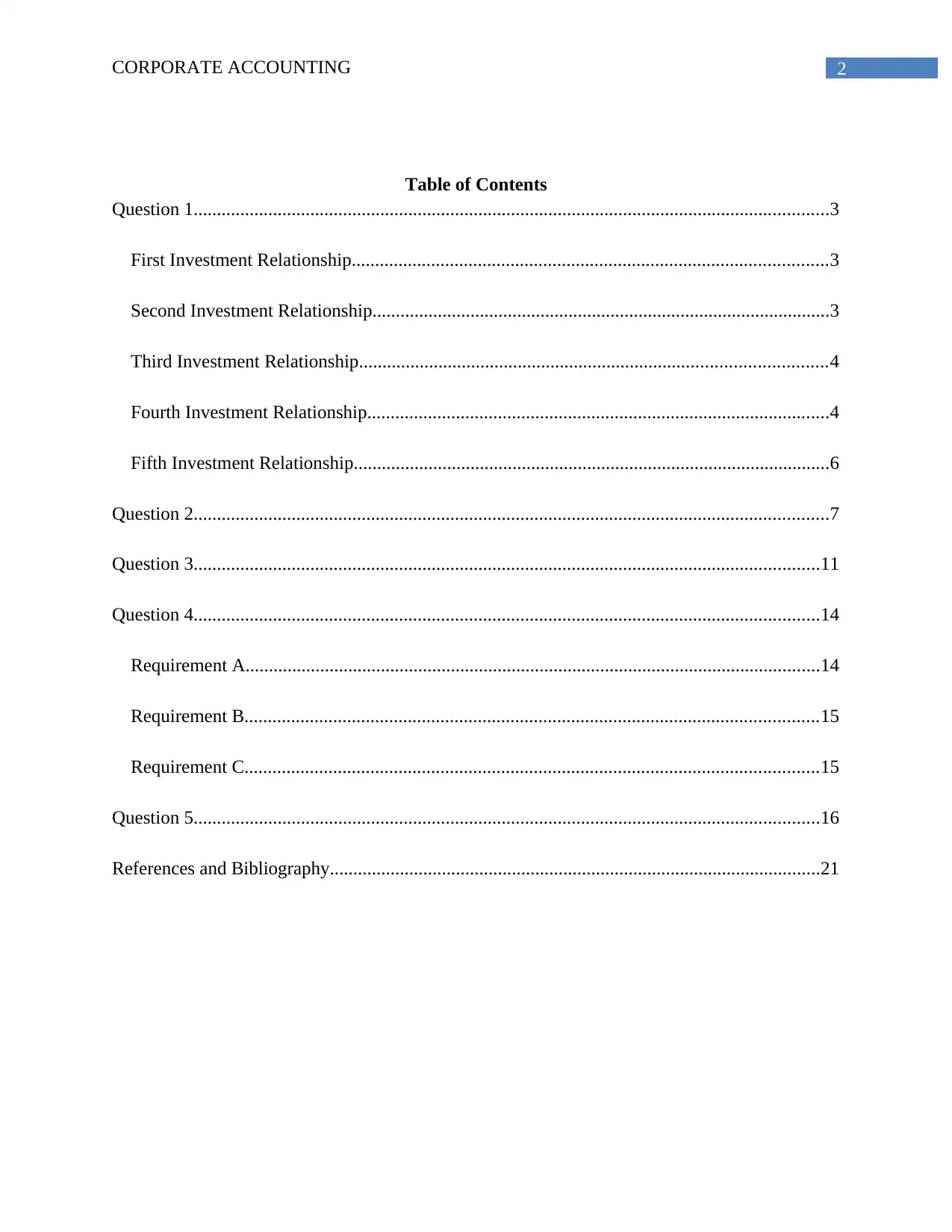
2CORPORATE ACCOUNTING
Table of Contents
Question 1........................................................................................................................................3
First Investment Relationship......................................................................................................3
Second Investment Relationship..................................................................................................3
Third Investment Relationship....................................................................................................4
Fourth Investment Relationship...................................................................................................4
Fifth Investment Relationship......................................................................................................6
Question 2........................................................................................................................................7
Question 3......................................................................................................................................11
Question 4......................................................................................................................................14
Requirement A...........................................................................................................................14
Requirement B...........................................................................................................................15
Requirement C...........................................................................................................................15
Question 5......................................................................................................................................16
References and Bibliography.........................................................................................................21
Table of Contents
Question 1........................................................................................................................................3
First Investment Relationship......................................................................................................3
Second Investment Relationship..................................................................................................3
Third Investment Relationship....................................................................................................4
Fourth Investment Relationship...................................................................................................4
Fifth Investment Relationship......................................................................................................6
Question 2........................................................................................................................................7
Question 3......................................................................................................................................11
Question 4......................................................................................................................................14
Requirement A...........................................................................................................................14
Requirement B...........................................................................................................................15
Requirement C...........................................................................................................................15
Question 5......................................................................................................................................16
References and Bibliography.........................................................................................................21
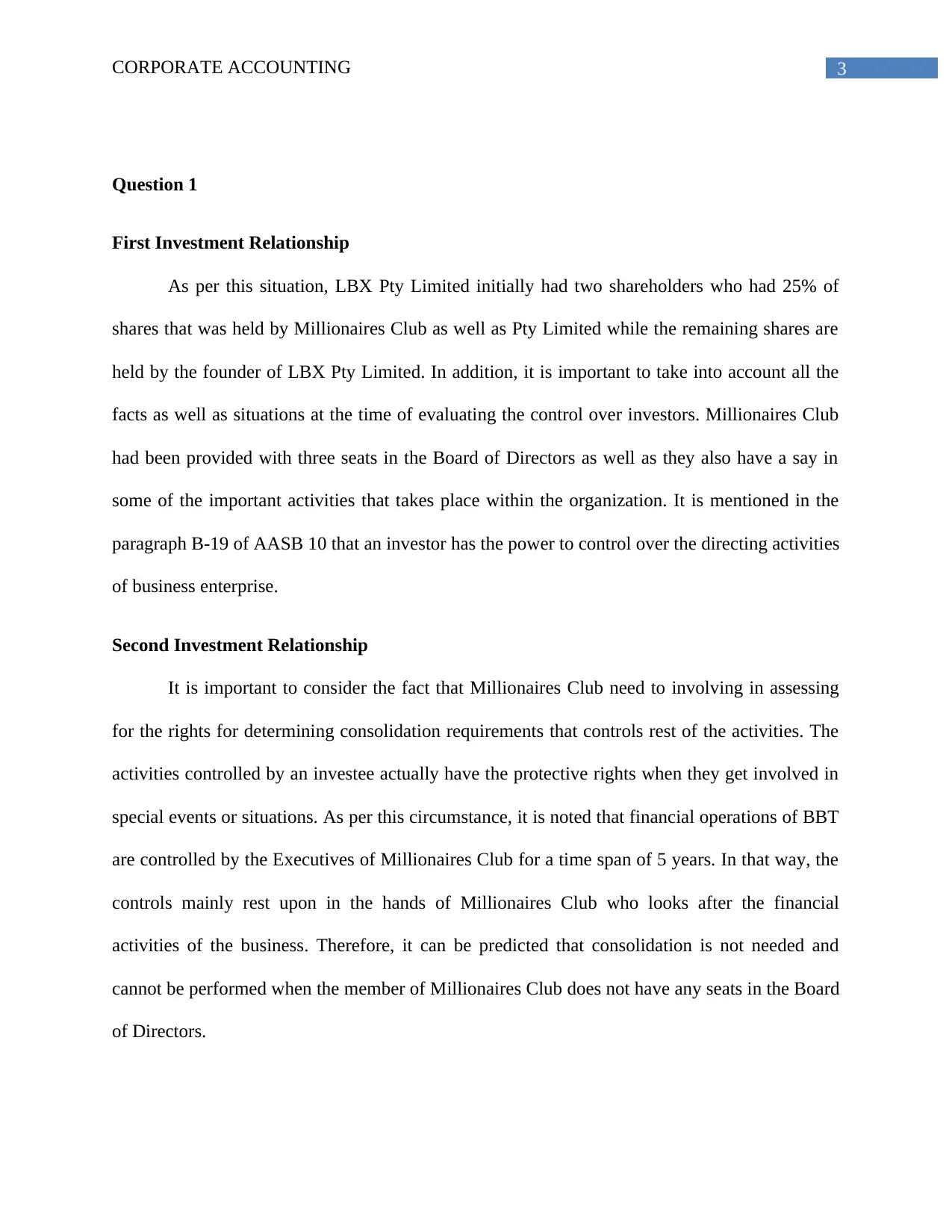
3CORPORATE ACCOUNTING
Question 1
First Investment Relationship
As per this situation, LBX Pty Limited initially had two shareholders who had 25% of
shares that was held by Millionaires Club as well as Pty Limited while the remaining shares are
held by the founder of LBX Pty Limited. In addition, it is important to take into account all the
facts as well as situations at the time of evaluating the control over investors. Millionaires Club
had been provided with three seats in the Board of Directors as well as they also have a say in
some of the important activities that takes place within the organization. It is mentioned in the
paragraph B-19 of AASB 10 that an investor has the power to control over the directing activities
of business enterprise.
Second Investment Relationship
It is important to consider the fact that Millionaires Club need to involving in assessing
for the rights for determining consolidation requirements that controls rest of the activities. The
activities controlled by an investee actually have the protective rights when they get involved in
special events or situations. As per this circumstance, it is noted that financial operations of BBT
are controlled by the Executives of Millionaires Club for a time span of 5 years. In that way, the
controls mainly rest upon in the hands of Millionaires Club who looks after the financial
activities of the business. Therefore, it can be predicted that consolidation is not needed and
cannot be performed when the member of Millionaires Club does not have any seats in the Board
of Directors.
Question 1
First Investment Relationship
As per this situation, LBX Pty Limited initially had two shareholders who had 25% of
shares that was held by Millionaires Club as well as Pty Limited while the remaining shares are
held by the founder of LBX Pty Limited. In addition, it is important to take into account all the
facts as well as situations at the time of evaluating the control over investors. Millionaires Club
had been provided with three seats in the Board of Directors as well as they also have a say in
some of the important activities that takes place within the organization. It is mentioned in the
paragraph B-19 of AASB 10 that an investor has the power to control over the directing activities
of business enterprise.
Second Investment Relationship
It is important to consider the fact that Millionaires Club need to involving in assessing
for the rights for determining consolidation requirements that controls rest of the activities. The
activities controlled by an investee actually have the protective rights when they get involved in
special events or situations. As per this circumstance, it is noted that financial operations of BBT
are controlled by the Executives of Millionaires Club for a time span of 5 years. In that way, the
controls mainly rest upon in the hands of Millionaires Club who looks after the financial
activities of the business. Therefore, it can be predicted that consolidation is not needed and
cannot be performed when the member of Millionaires Club does not have any seats in the Board
of Directors.
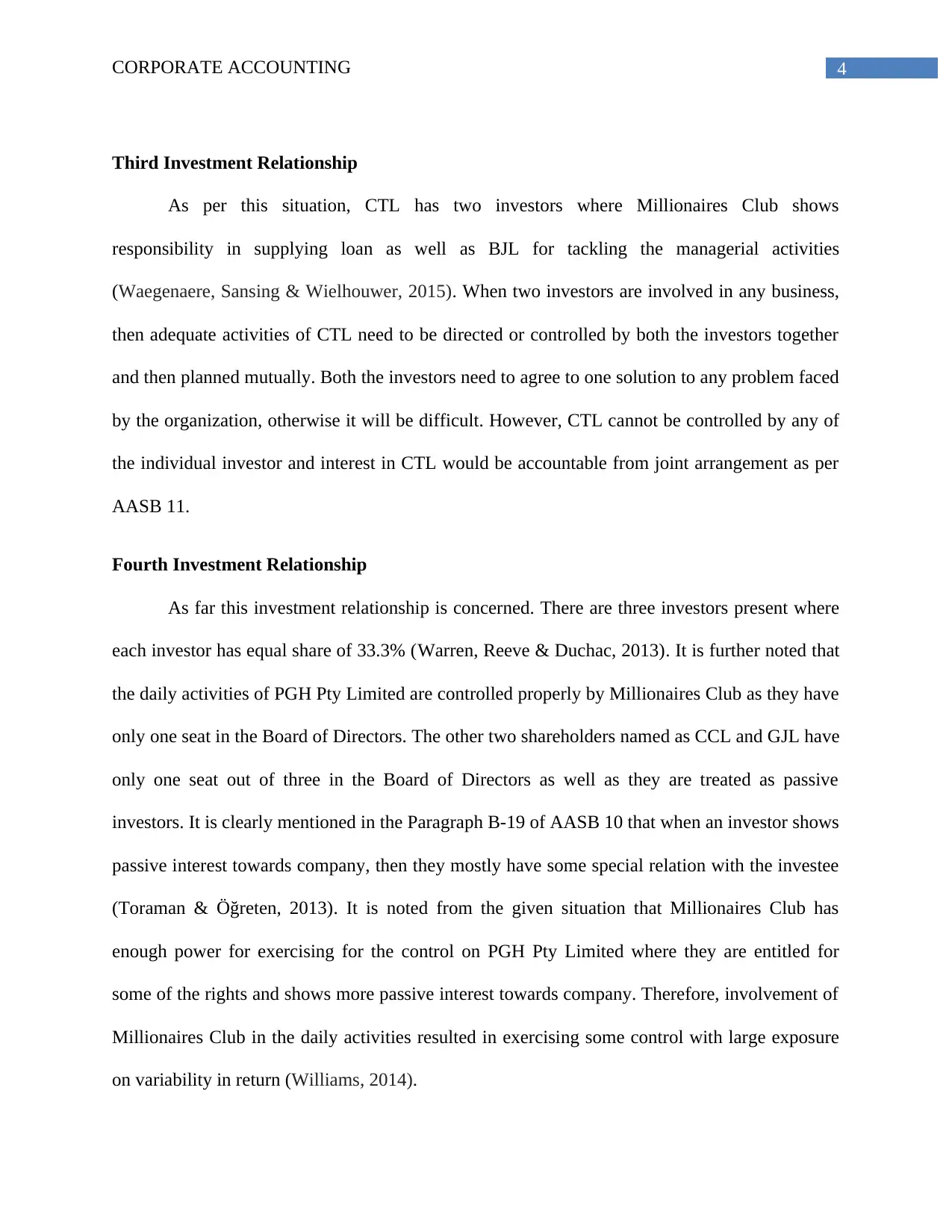
4CORPORATE ACCOUNTING
Third Investment Relationship
As per this situation, CTL has two investors where Millionaires Club shows
responsibility in supplying loan as well as BJL for tackling the managerial activities
(Waegenaere, Sansing & Wielhouwer, 2015). When two investors are involved in any business,
then adequate activities of CTL need to be directed or controlled by both the investors together
and then planned mutually. Both the investors need to agree to one solution to any problem faced
by the organization, otherwise it will be difficult. However, CTL cannot be controlled by any of
the individual investor and interest in CTL would be accountable from joint arrangement as per
AASB 11.
Fourth Investment Relationship
As far this investment relationship is concerned. There are three investors present where
each investor has equal share of 33.3% (Warren, Reeve & Duchac, 2013). It is further noted that
the daily activities of PGH Pty Limited are controlled properly by Millionaires Club as they have
only one seat in the Board of Directors. The other two shareholders named as CCL and GJL have
only one seat out of three in the Board of Directors as well as they are treated as passive
investors. It is clearly mentioned in the Paragraph B-19 of AASB 10 that when an investor shows
passive interest towards company, then they mostly have some special relation with the investee
(Toraman & Öğreten, 2013). It is noted from the given situation that Millionaires Club has
enough power for exercising for the control on PGH Pty Limited where they are entitled for
some of the rights and shows more passive interest towards company. Therefore, involvement of
Millionaires Club in the daily activities resulted in exercising some control with large exposure
on variability in return (Williams, 2014).
Third Investment Relationship
As per this situation, CTL has two investors where Millionaires Club shows
responsibility in supplying loan as well as BJL for tackling the managerial activities
(Waegenaere, Sansing & Wielhouwer, 2015). When two investors are involved in any business,
then adequate activities of CTL need to be directed or controlled by both the investors together
and then planned mutually. Both the investors need to agree to one solution to any problem faced
by the organization, otherwise it will be difficult. However, CTL cannot be controlled by any of
the individual investor and interest in CTL would be accountable from joint arrangement as per
AASB 11.
Fourth Investment Relationship
As far this investment relationship is concerned. There are three investors present where
each investor has equal share of 33.3% (Warren, Reeve & Duchac, 2013). It is further noted that
the daily activities of PGH Pty Limited are controlled properly by Millionaires Club as they have
only one seat in the Board of Directors. The other two shareholders named as CCL and GJL have
only one seat out of three in the Board of Directors as well as they are treated as passive
investors. It is clearly mentioned in the Paragraph B-19 of AASB 10 that when an investor shows
passive interest towards company, then they mostly have some special relation with the investee
(Toraman & Öğreten, 2013). It is noted from the given situation that Millionaires Club has
enough power for exercising for the control on PGH Pty Limited where they are entitled for
some of the rights and shows more passive interest towards company. Therefore, involvement of
Millionaires Club in the daily activities resulted in exercising some control with large exposure
on variability in return (Williams, 2014).
Secure Best Marks with AI Grader
Need help grading? Try our AI Grader for instant feedback on your assignments.
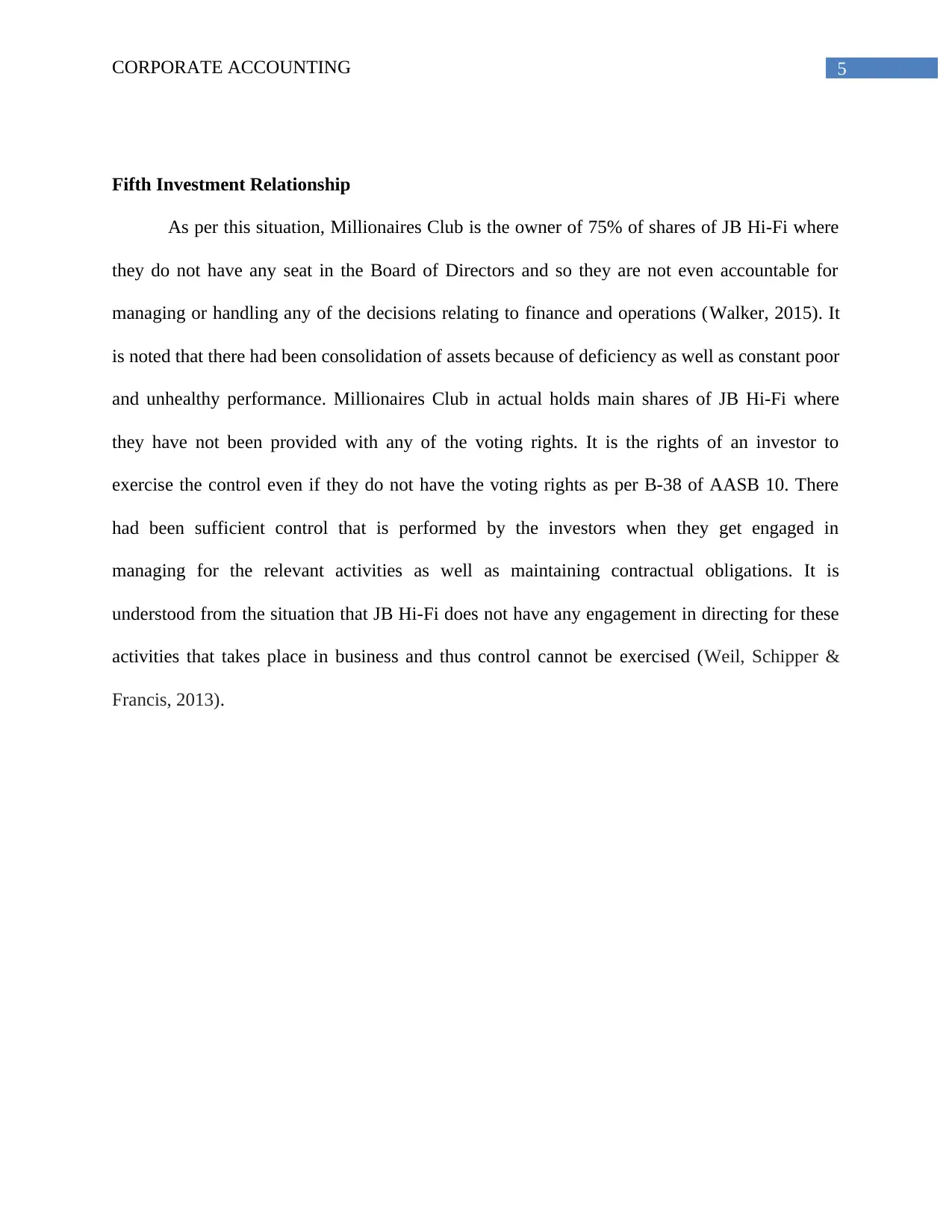
5CORPORATE ACCOUNTING
Fifth Investment Relationship
As per this situation, Millionaires Club is the owner of 75% of shares of JB Hi-Fi where
they do not have any seat in the Board of Directors and so they are not even accountable for
managing or handling any of the decisions relating to finance and operations (Walker, 2015). It
is noted that there had been consolidation of assets because of deficiency as well as constant poor
and unhealthy performance. Millionaires Club in actual holds main shares of JB Hi-Fi where
they have not been provided with any of the voting rights. It is the rights of an investor to
exercise the control even if they do not have the voting rights as per B-38 of AASB 10. There
had been sufficient control that is performed by the investors when they get engaged in
managing for the relevant activities as well as maintaining contractual obligations. It is
understood from the situation that JB Hi-Fi does not have any engagement in directing for these
activities that takes place in business and thus control cannot be exercised (Weil, Schipper &
Francis, 2013).
Fifth Investment Relationship
As per this situation, Millionaires Club is the owner of 75% of shares of JB Hi-Fi where
they do not have any seat in the Board of Directors and so they are not even accountable for
managing or handling any of the decisions relating to finance and operations (Walker, 2015). It
is noted that there had been consolidation of assets because of deficiency as well as constant poor
and unhealthy performance. Millionaires Club in actual holds main shares of JB Hi-Fi where
they have not been provided with any of the voting rights. It is the rights of an investor to
exercise the control even if they do not have the voting rights as per B-38 of AASB 10. There
had been sufficient control that is performed by the investors when they get engaged in
managing for the relevant activities as well as maintaining contractual obligations. It is
understood from the situation that JB Hi-Fi does not have any engagement in directing for these
activities that takes place in business and thus control cannot be exercised (Weil, Schipper &
Francis, 2013).
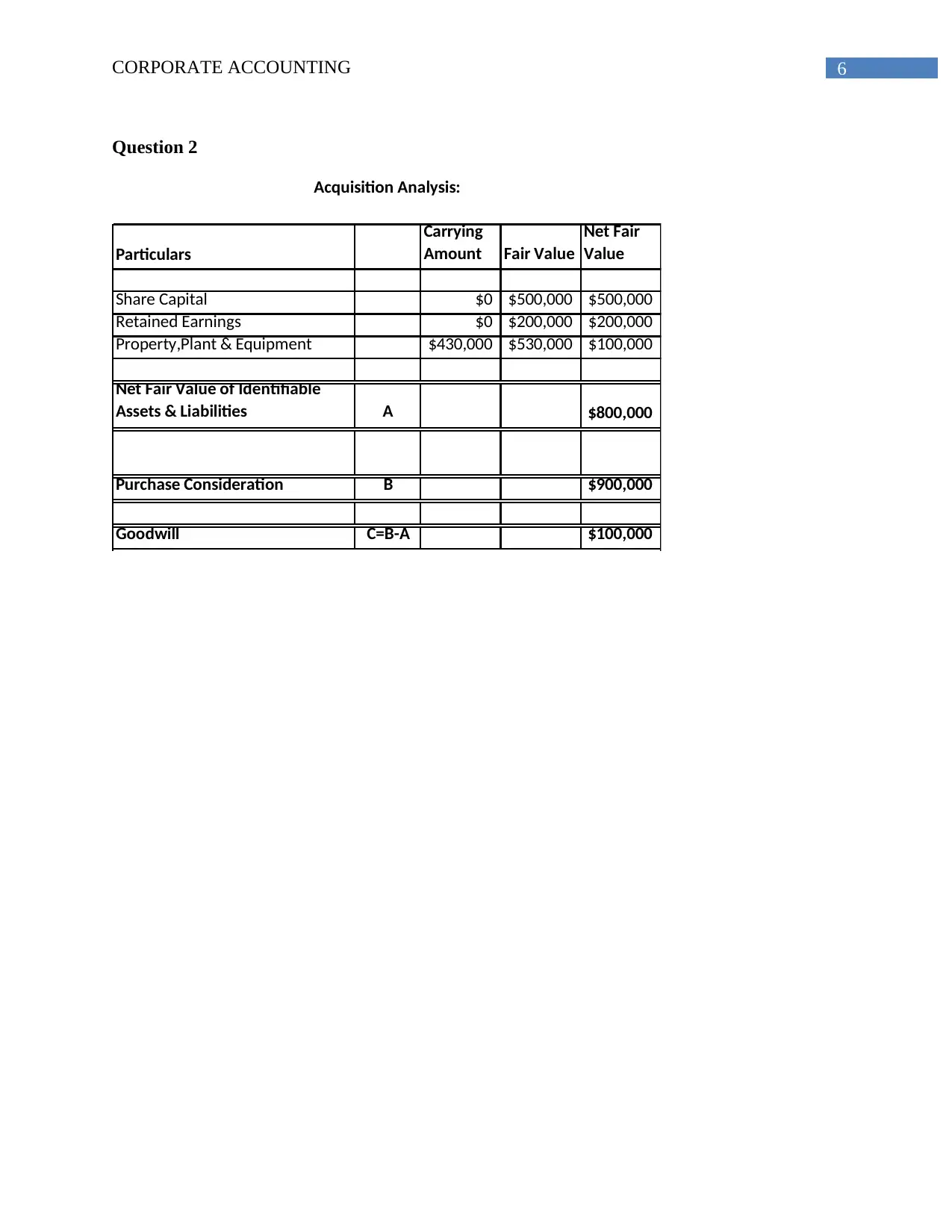
6CORPORATE ACCOUNTING
Question 2
Particulars
Carrying
Amount Fair Value
Net Fair
Value
Share Capital $0 $500,000 $500,000
Retained Earnings $0 $200,000 $200,000
Property,Plant & Equipment $430,000 $530,000 $100,000
Net Fair Value of Identifiable
Assets & Liabilities A $800,000
Purchase Consideration B $900,000
Goodwill C=B-A $100,000
Acquisition Analysis:
Question 2
Particulars
Carrying
Amount Fair Value
Net Fair
Value
Share Capital $0 $500,000 $500,000
Retained Earnings $0 $200,000 $200,000
Property,Plant & Equipment $430,000 $530,000 $100,000
Net Fair Value of Identifiable
Assets & Liabilities A $800,000
Purchase Consideration B $900,000
Goodwill C=B-A $100,000
Acquisition Analysis:
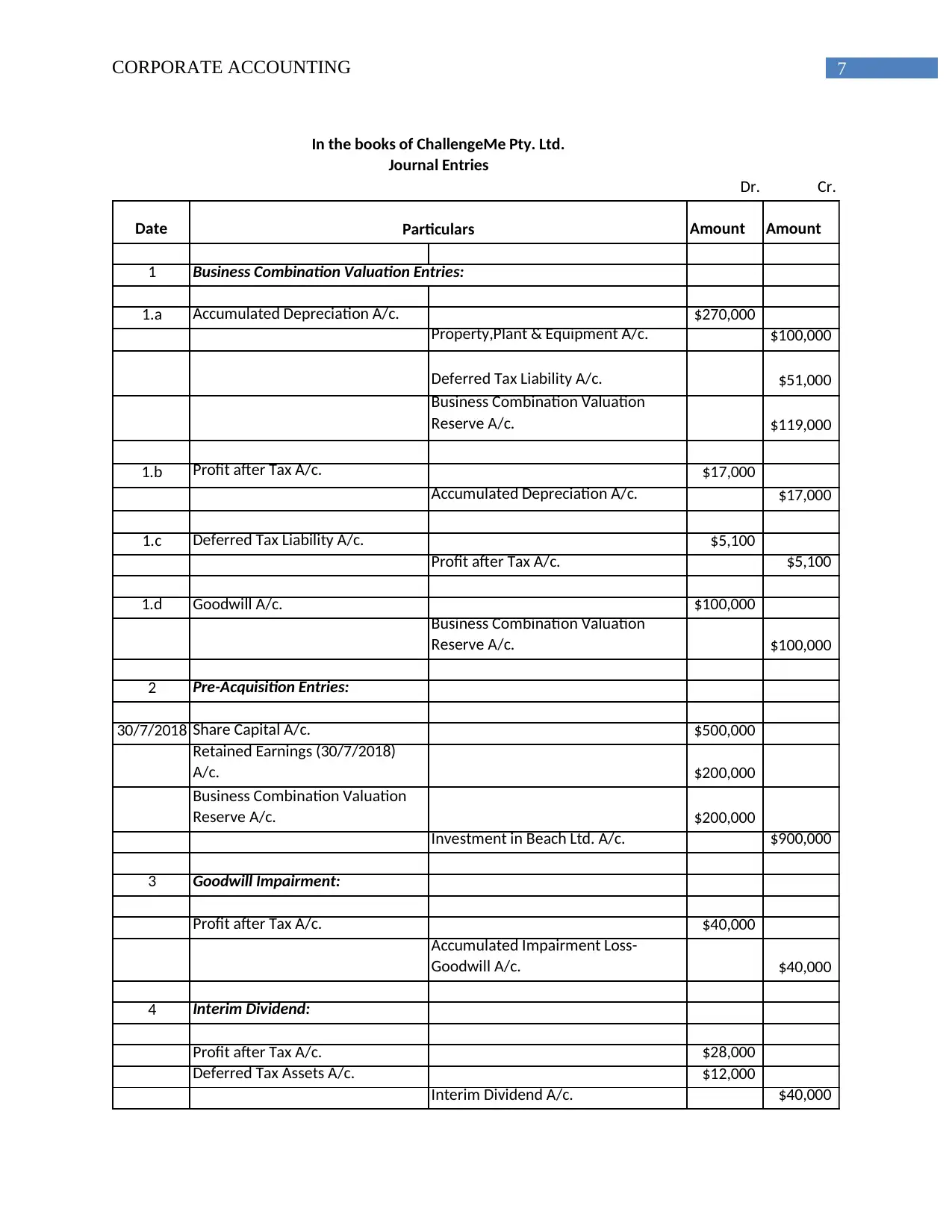
7CORPORATE ACCOUNTING
Dr. Cr.
Date Amount Amount
1
1.a Accumulated Depreciation A/c. $270,000
Property,Plant & Equipment A/c. $100,000
Deferred Tax Liability A/c. $51,000
Business Combination Valuation
Reserve A/c. $119,000
1.b Profit after Tax A/c. $17,000
Accumulated Depreciation A/c. $17,000
1.c Deferred Tax Liability A/c. $5,100
Profit after Tax A/c. $5,100
1.d Goodwill A/c. $100,000
Business Combination Valuation
Reserve A/c. $100,000
2 Pre-Acquisition Entries:
30/7/2018 Share Capital A/c. $500,000
Retained Earnings (30/7/2018)
A/c. $200,000
Business Combination Valuation
Reserve A/c. $200,000
Investment in Beach Ltd. A/c. $900,000
3 Goodwill Impairment:
Profit after Tax A/c. $40,000
Accumulated Impairment Loss-
Goodwill A/c. $40,000
4 Interim Dividend:
Profit after Tax A/c. $28,000
Deferred Tax Assets A/c. $12,000
Interim Dividend A/c. $40,000
Particulars
Business Combination Valuation Entries:
In the books of ChallengeMe Pty. Ltd.
Journal Entries
Dr. Cr.
Date Amount Amount
1
1.a Accumulated Depreciation A/c. $270,000
Property,Plant & Equipment A/c. $100,000
Deferred Tax Liability A/c. $51,000
Business Combination Valuation
Reserve A/c. $119,000
1.b Profit after Tax A/c. $17,000
Accumulated Depreciation A/c. $17,000
1.c Deferred Tax Liability A/c. $5,100
Profit after Tax A/c. $5,100
1.d Goodwill A/c. $100,000
Business Combination Valuation
Reserve A/c. $100,000
2 Pre-Acquisition Entries:
30/7/2018 Share Capital A/c. $500,000
Retained Earnings (30/7/2018)
A/c. $200,000
Business Combination Valuation
Reserve A/c. $200,000
Investment in Beach Ltd. A/c. $900,000
3 Goodwill Impairment:
Profit after Tax A/c. $40,000
Accumulated Impairment Loss-
Goodwill A/c. $40,000
4 Interim Dividend:
Profit after Tax A/c. $28,000
Deferred Tax Assets A/c. $12,000
Interim Dividend A/c. $40,000
Particulars
Business Combination Valuation Entries:
In the books of ChallengeMe Pty. Ltd.
Journal Entries
Paraphrase This Document
Need a fresh take? Get an instant paraphrase of this document with our AI Paraphraser
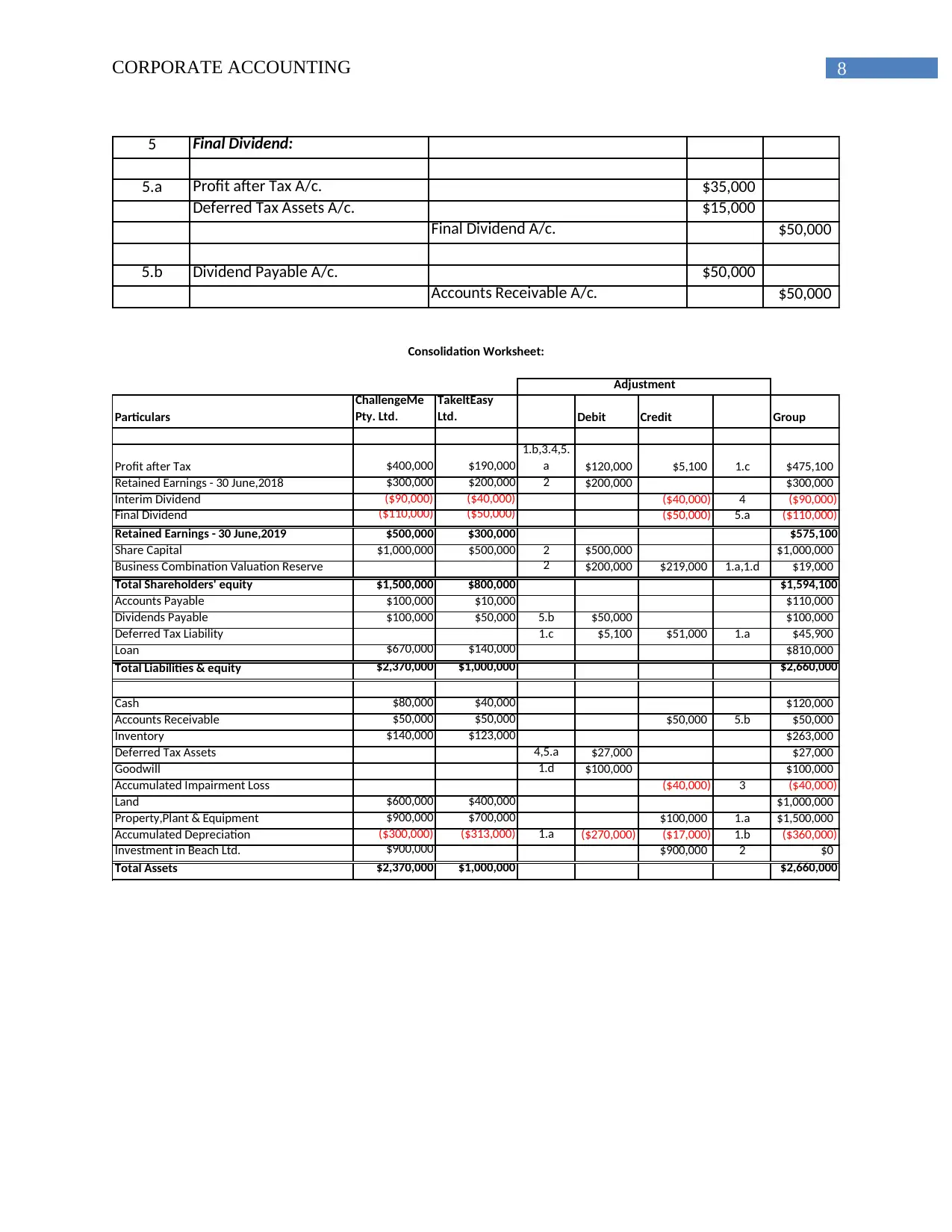
8CORPORATE ACCOUNTING
5 Final Dividend:
5.a Profit after Tax A/c. $35,000
Deferred Tax Assets A/c. $15,000
Final Dividend A/c. $50,000
5.b Dividend Payable A/c. $50,000
Accounts Receivable A/c. $50,000
Particulars
ChallengeMe
Pty. Ltd.
TakeItEasy
Ltd. Debit Credit Group
Profit after Tax $400,000 $190,000
1.b,3.4,5.
a $120,000 $5,100 1.c $475,100
Retained Earnings - 30 June,2018 $300,000 $200,000 2 $200,000 $300,000
Interim Dividend ($90,000) ($40,000) ($40,000) 4 ($90,000)
Final Dividend ($110,000) ($50,000) ($50,000) 5.a ($110,000)
Retained Earnings - 30 June,2019 $500,000 $300,000 $575,100
Share Capital $1,000,000 $500,000 2 $500,000 $1,000,000
Business Combination Valuation Reserve 2 $200,000 $219,000 1.a,1.d $19,000
Total Shareholders' equity $1,500,000 $800,000 $1,594,100
Accounts Payable $100,000 $10,000 $110,000
Dividends Payable $100,000 $50,000 5.b $50,000 $100,000
Deferred Tax Liability 1.c $5,100 $51,000 1.a $45,900
Loan $670,000 $140,000 $810,000
Total Liabilities & equity $2,370,000 $1,000,000 $2,660,000
Cash $80,000 $40,000 $120,000
Accounts Receivable $50,000 $50,000 $50,000 5.b $50,000
Inventory $140,000 $123,000 $263,000
Deferred Tax Assets 4,5.a $27,000 $27,000
Goodwill 1.d $100,000 $100,000
Accumulated Impairment Loss ($40,000) 3 ($40,000)
Land $600,000 $400,000 $1,000,000
Property,Plant & Equipment $900,000 $700,000 $100,000 1.a $1,500,000
Accumulated Depreciation ($300,000) ($313,000) 1.a ($270,000) ($17,000) 1.b ($360,000)
Investment in Beach Ltd. $900,000 $900,000 2 $0
Total Assets $2,370,000 $1,000,000 $2,660,000
Adjustment
Consolidation Worksheet:
5 Final Dividend:
5.a Profit after Tax A/c. $35,000
Deferred Tax Assets A/c. $15,000
Final Dividend A/c. $50,000
5.b Dividend Payable A/c. $50,000
Accounts Receivable A/c. $50,000
Particulars
ChallengeMe
Pty. Ltd.
TakeItEasy
Ltd. Debit Credit Group
Profit after Tax $400,000 $190,000
1.b,3.4,5.
a $120,000 $5,100 1.c $475,100
Retained Earnings - 30 June,2018 $300,000 $200,000 2 $200,000 $300,000
Interim Dividend ($90,000) ($40,000) ($40,000) 4 ($90,000)
Final Dividend ($110,000) ($50,000) ($50,000) 5.a ($110,000)
Retained Earnings - 30 June,2019 $500,000 $300,000 $575,100
Share Capital $1,000,000 $500,000 2 $500,000 $1,000,000
Business Combination Valuation Reserve 2 $200,000 $219,000 1.a,1.d $19,000
Total Shareholders' equity $1,500,000 $800,000 $1,594,100
Accounts Payable $100,000 $10,000 $110,000
Dividends Payable $100,000 $50,000 5.b $50,000 $100,000
Deferred Tax Liability 1.c $5,100 $51,000 1.a $45,900
Loan $670,000 $140,000 $810,000
Total Liabilities & equity $2,370,000 $1,000,000 $2,660,000
Cash $80,000 $40,000 $120,000
Accounts Receivable $50,000 $50,000 $50,000 5.b $50,000
Inventory $140,000 $123,000 $263,000
Deferred Tax Assets 4,5.a $27,000 $27,000
Goodwill 1.d $100,000 $100,000
Accumulated Impairment Loss ($40,000) 3 ($40,000)
Land $600,000 $400,000 $1,000,000
Property,Plant & Equipment $900,000 $700,000 $100,000 1.a $1,500,000
Accumulated Depreciation ($300,000) ($313,000) 1.a ($270,000) ($17,000) 1.b ($360,000)
Investment in Beach Ltd. $900,000 $900,000 2 $0
Total Assets $2,370,000 $1,000,000 $2,660,000
Adjustment
Consolidation Worksheet:
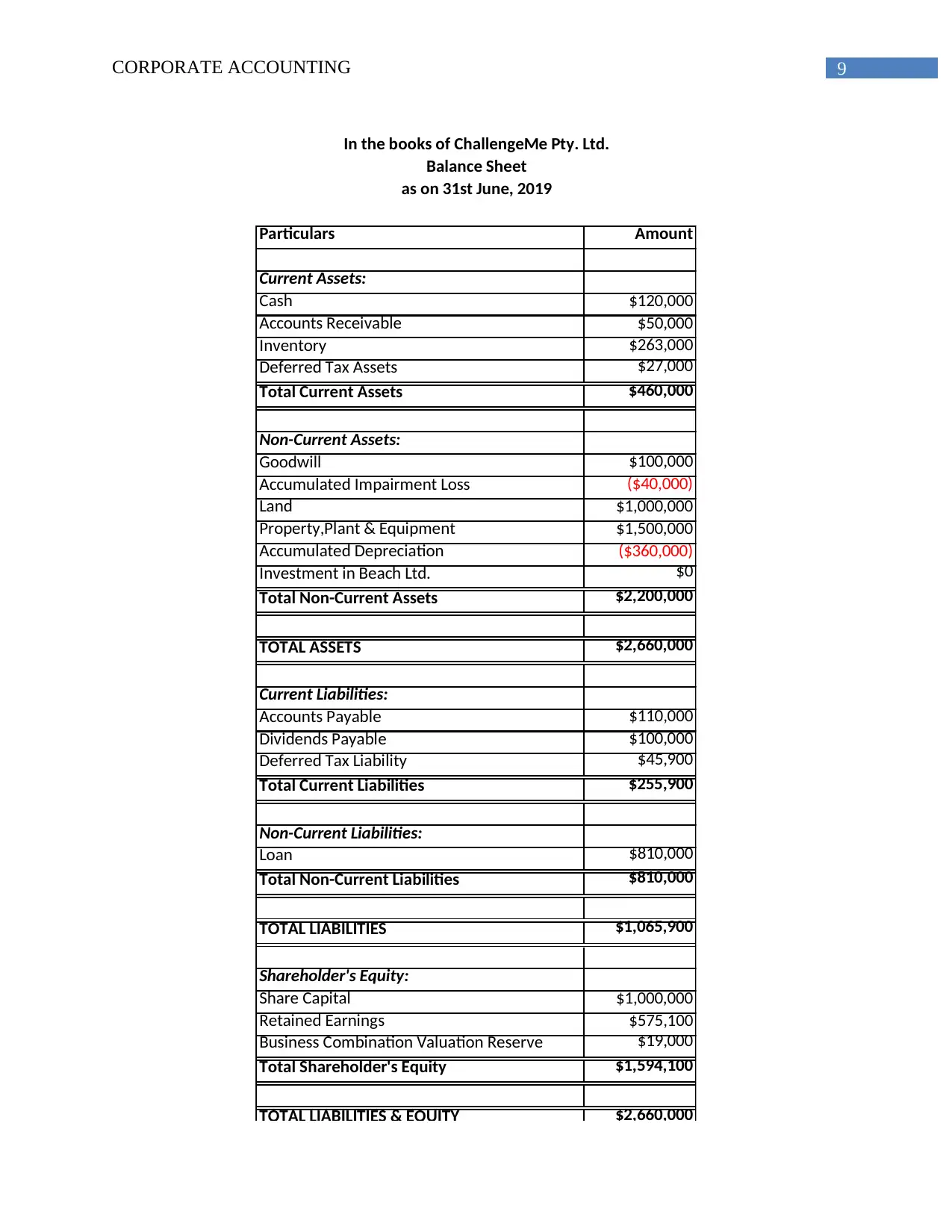
9CORPORATE ACCOUNTING
Particulars Amount
Current Assets:
Cash $120,000
Accounts Receivable $50,000
Inventory $263,000
Deferred Tax Assets $27,000
Total Current Assets $460,000
Non-Current Assets:
Goodwill $100,000
Accumulated Impairment Loss ($40,000)
Land $1,000,000
Property,Plant & Equipment $1,500,000
Accumulated Depreciation ($360,000)
Investment in Beach Ltd. $0
Total Non-Current Assets $2,200,000
TOTAL ASSETS $2,660,000
Current Liabilities:
Accounts Payable $110,000
Dividends Payable $100,000
Deferred Tax Liability $45,900
Total Current Liabilities $255,900
Non-Current Liabilities:
Loan $810,000
Total Non-Current Liabilities $810,000
TOTAL LIABILITIES $1,065,900
Shareholder's Equity:
Share Capital $1,000,000
Retained Earnings $575,100
Business Combination Valuation Reserve $19,000
Total Shareholder's Equity $1,594,100
TOTAL LIABILITIES & EQUITY $2,660,000
In the books of ChallengeMe Pty. Ltd.
Balance Sheet
as on 31st June, 2019
Particulars Amount
Current Assets:
Cash $120,000
Accounts Receivable $50,000
Inventory $263,000
Deferred Tax Assets $27,000
Total Current Assets $460,000
Non-Current Assets:
Goodwill $100,000
Accumulated Impairment Loss ($40,000)
Land $1,000,000
Property,Plant & Equipment $1,500,000
Accumulated Depreciation ($360,000)
Investment in Beach Ltd. $0
Total Non-Current Assets $2,200,000
TOTAL ASSETS $2,660,000
Current Liabilities:
Accounts Payable $110,000
Dividends Payable $100,000
Deferred Tax Liability $45,900
Total Current Liabilities $255,900
Non-Current Liabilities:
Loan $810,000
Total Non-Current Liabilities $810,000
TOTAL LIABILITIES $1,065,900
Shareholder's Equity:
Share Capital $1,000,000
Retained Earnings $575,100
Business Combination Valuation Reserve $19,000
Total Shareholder's Equity $1,594,100
TOTAL LIABILITIES & EQUITY $2,660,000
In the books of ChallengeMe Pty. Ltd.
Balance Sheet
as on 31st June, 2019
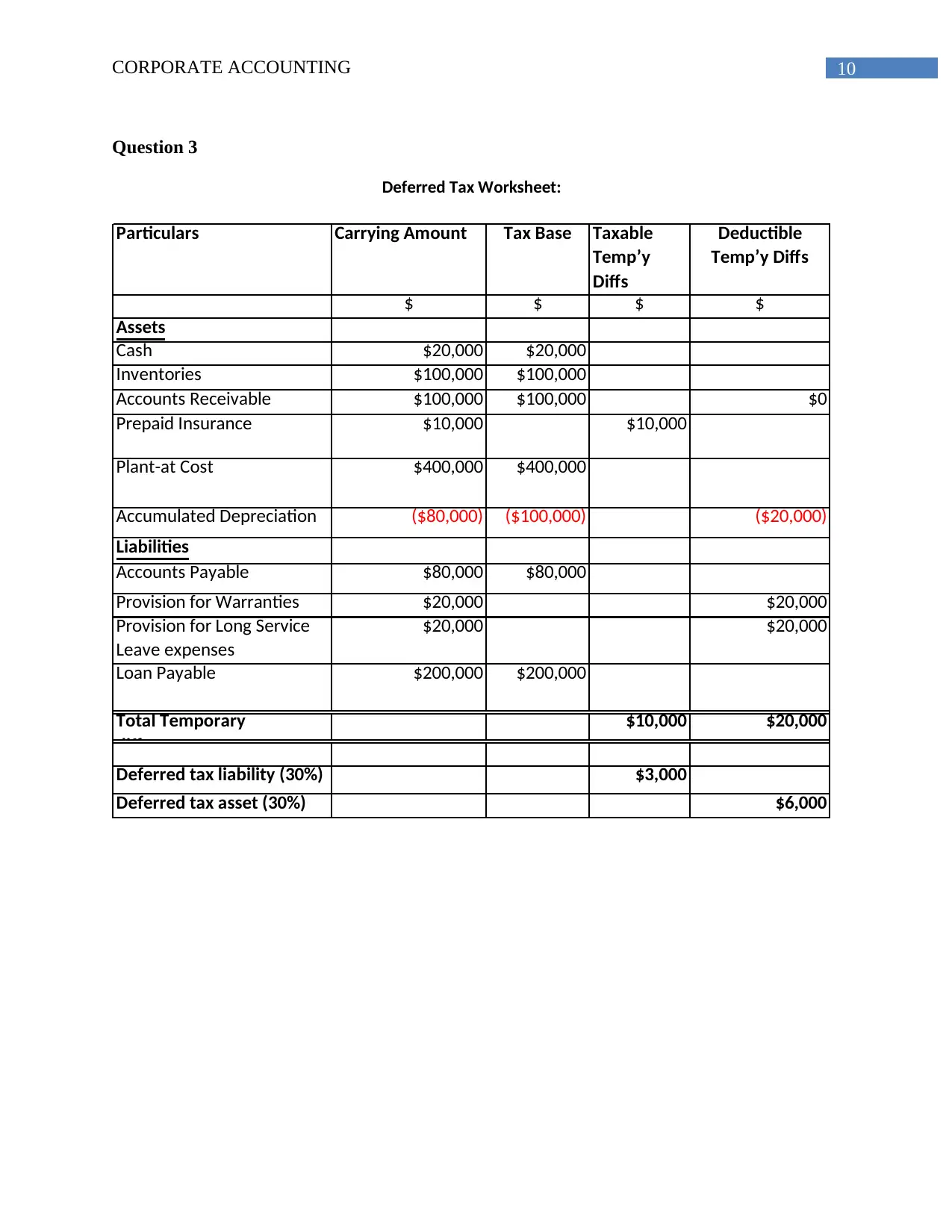
10CORPORATE ACCOUNTING
Question 3
Particulars Carrying Amount Tax Base Taxable
Temp’y
Diffs
Deductible
Temp’y Diffs
$ $ $ $
Assets
Cash $20,000 $20,000
Inventories $100,000 $100,000
Accounts Receivable $100,000 $100,000 $0
Prepaid Insurance $10,000 $10,000
Plant-at Cost $400,000 $400,000
Accumulated Depreciation ($80,000) ($100,000) ($20,000)
Liabilities
Accounts Payable $80,000 $80,000
Provision for Warranties $20,000 $20,000
Provision for Long Service
Leave expenses
$20,000 $20,000
Loan Payable $200,000 $200,000
Total Temporary
differences
$10,000 $20,000
Deferred tax liability (30%) $3,000
Deferred tax asset (30%) $6,000
Deferred Tax Worksheet:
Question 3
Particulars Carrying Amount Tax Base Taxable
Temp’y
Diffs
Deductible
Temp’y Diffs
$ $ $ $
Assets
Cash $20,000 $20,000
Inventories $100,000 $100,000
Accounts Receivable $100,000 $100,000 $0
Prepaid Insurance $10,000 $10,000
Plant-at Cost $400,000 $400,000
Accumulated Depreciation ($80,000) ($100,000) ($20,000)
Liabilities
Accounts Payable $80,000 $80,000
Provision for Warranties $20,000 $20,000
Provision for Long Service
Leave expenses
$20,000 $20,000
Loan Payable $200,000 $200,000
Total Temporary
differences
$10,000 $20,000
Deferred tax liability (30%) $3,000
Deferred tax asset (30%) $6,000
Deferred Tax Worksheet:
Secure Best Marks with AI Grader
Need help grading? Try our AI Grader for instant feedback on your assignments.
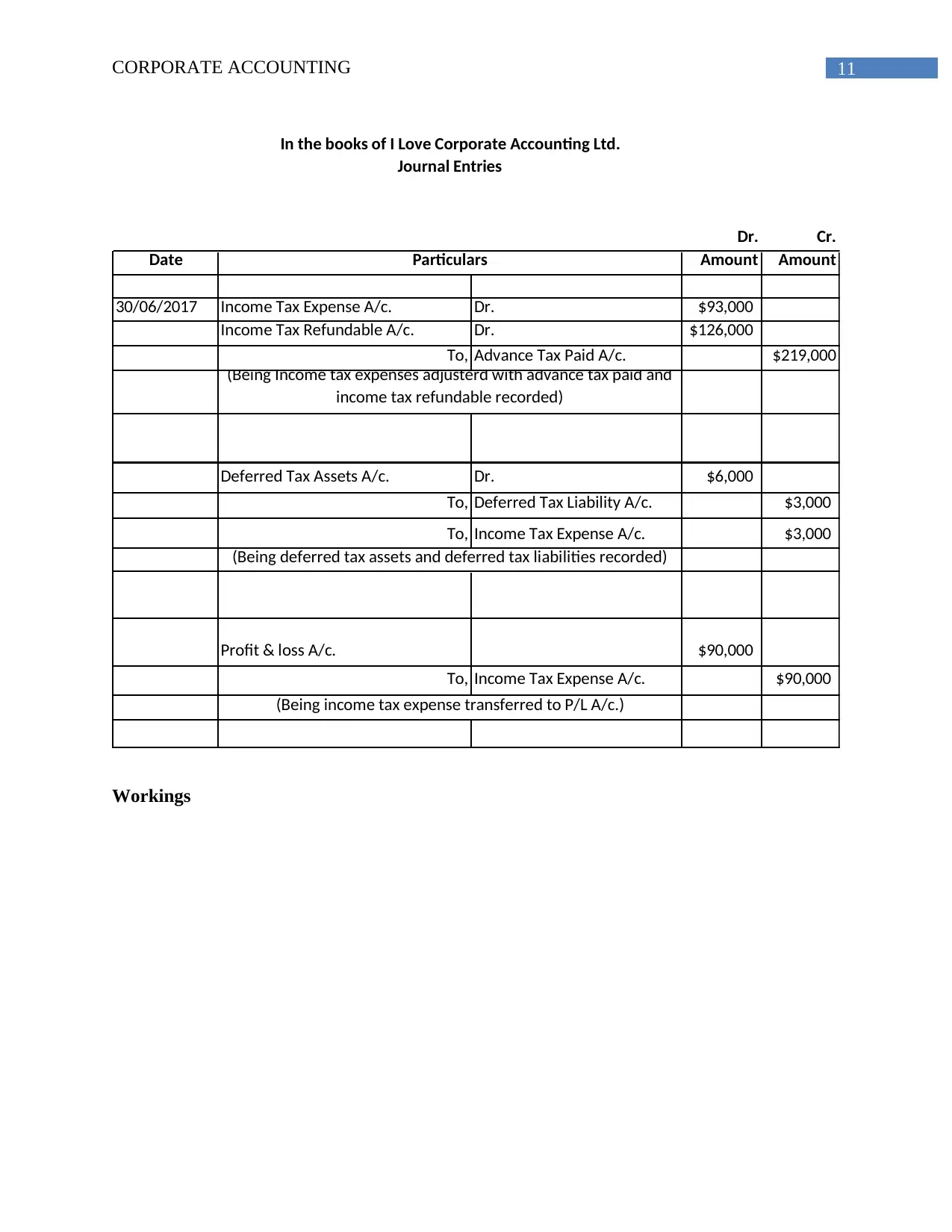
11CORPORATE ACCOUNTING
Dr. Cr.
Date Amount Amount
30/06/2017 Income Tax Expense A/c. Dr. $93,000
Income Tax Refundable A/c. Dr. $126,000
To, Advance Tax Paid A/c. $219,000
Deferred Tax Assets A/c. Dr. $6,000
To, Deferred Tax Liability A/c. $3,000
To, Income Tax Expense A/c. $3,000
Profit & loss A/c. $90,000
To, Income Tax Expense A/c. $90,000
(Being income tax expense transferred to P/L A/c.)
In the books of I Love Corporate Accounting Ltd.
Journal Entries
Particulars
(Being Income tax expenses adjusterd with advance tax paid and
income tax refundable recorded)
(Being deferred tax assets and deferred tax liabilities recorded)
Workings
Dr. Cr.
Date Amount Amount
30/06/2017 Income Tax Expense A/c. Dr. $93,000
Income Tax Refundable A/c. Dr. $126,000
To, Advance Tax Paid A/c. $219,000
Deferred Tax Assets A/c. Dr. $6,000
To, Deferred Tax Liability A/c. $3,000
To, Income Tax Expense A/c. $3,000
Profit & loss A/c. $90,000
To, Income Tax Expense A/c. $90,000
(Being income tax expense transferred to P/L A/c.)
In the books of I Love Corporate Accounting Ltd.
Journal Entries
Particulars
(Being Income tax expenses adjusterd with advance tax paid and
income tax refundable recorded)
(Being deferred tax assets and deferred tax liabilities recorded)
Workings
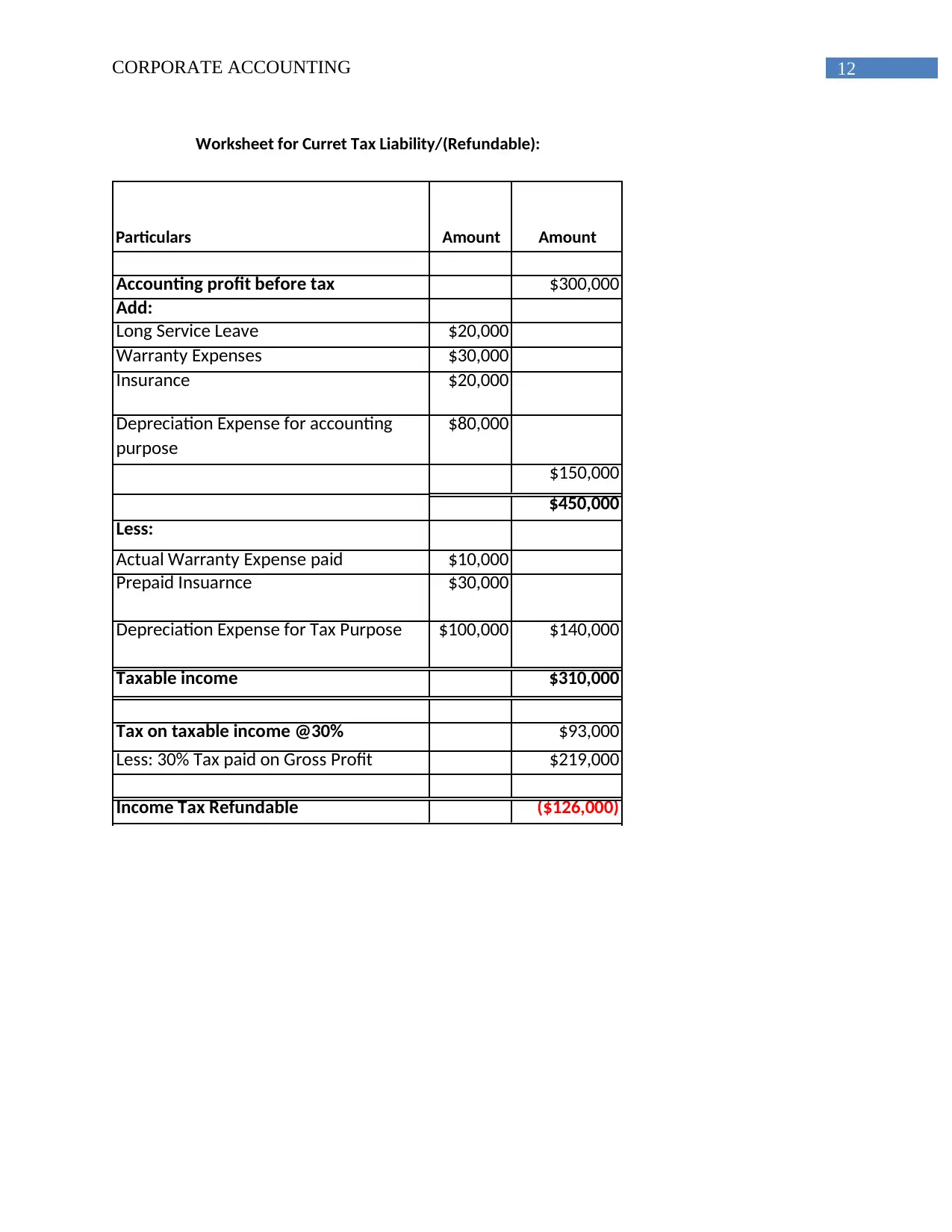
12CORPORATE ACCOUNTING
Particulars Amount Amount
Accounting profit before tax $300,000
Add:
Long Service Leave $20,000
Warranty Expenses $30,000
Insurance $20,000
Depreciation Expense for accounting
purpose
$80,000
$150,000
$450,000
Less:
Actual Warranty Expense paid $10,000
Prepaid Insuarnce $30,000
Depreciation Expense for Tax Purpose $100,000 $140,000
Taxable income $310,000
Tax on taxable income @30% $93,000
Less: 30% Tax paid on Gross Profit $219,000
Income Tax Refundable ($126,000)
Worksheet for Curret Tax Liability/(Refundable):
Particulars Amount Amount
Accounting profit before tax $300,000
Add:
Long Service Leave $20,000
Warranty Expenses $30,000
Insurance $20,000
Depreciation Expense for accounting
purpose
$80,000
$150,000
$450,000
Less:
Actual Warranty Expense paid $10,000
Prepaid Insuarnce $30,000
Depreciation Expense for Tax Purpose $100,000 $140,000
Taxable income $310,000
Tax on taxable income @30% $93,000
Less: 30% Tax paid on Gross Profit $219,000
Income Tax Refundable ($126,000)
Worksheet for Curret Tax Liability/(Refundable):
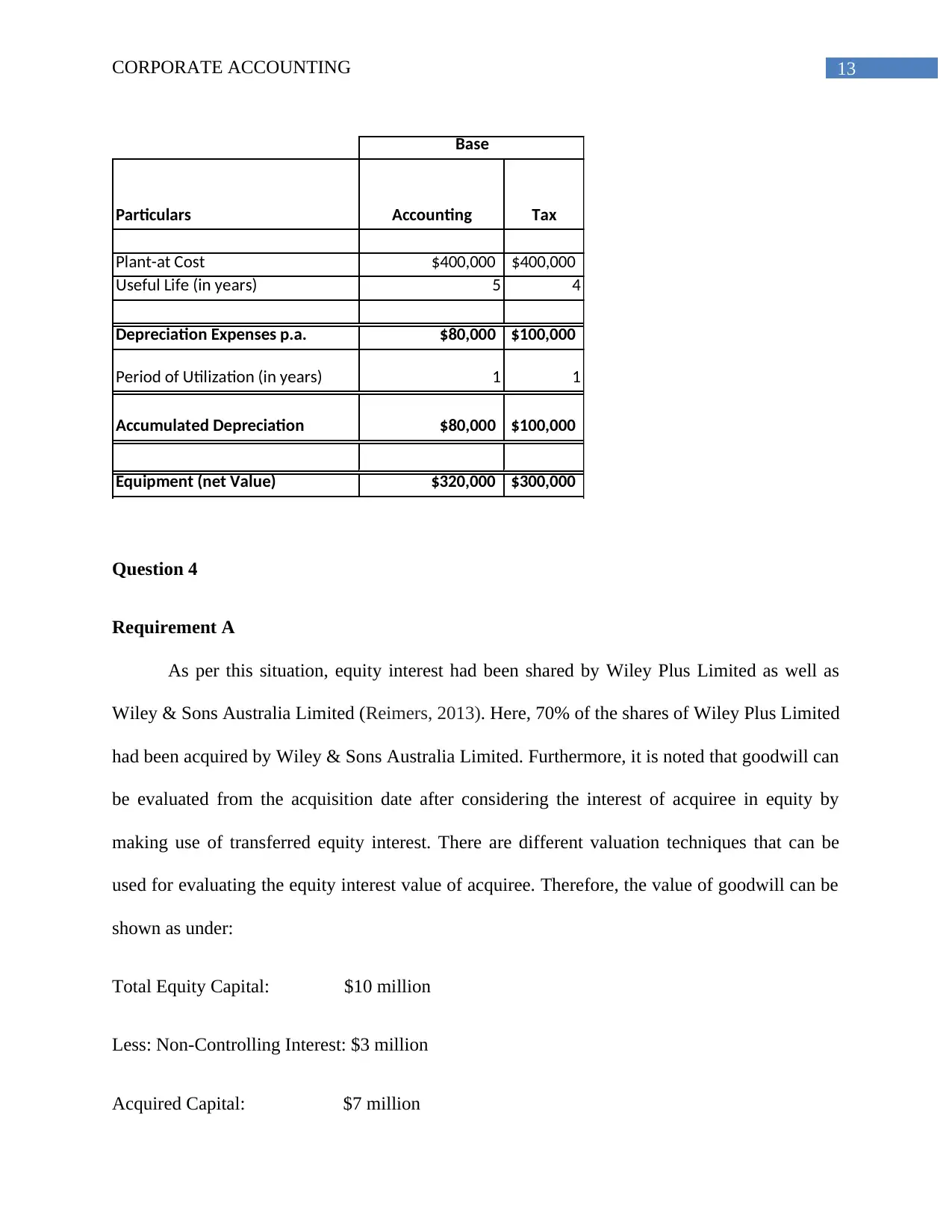
13CORPORATE ACCOUNTING
Particulars Accounting Tax
Plant-at Cost $400,000 $400,000
Useful Life (in years) 5 4
Depreciation Expenses p.a. $80,000 $100,000
Period of Utilization (in years) 1 1
Accumulated Depreciation $80,000 $100,000
Equipment (net Value) $320,000 $300,000
Base
Question 4
Requirement A
As per this situation, equity interest had been shared by Wiley Plus Limited as well as
Wiley & Sons Australia Limited (Reimers, 2013). Here, 70% of the shares of Wiley Plus Limited
had been acquired by Wiley & Sons Australia Limited. Furthermore, it is noted that goodwill can
be evaluated from the acquisition date after considering the interest of acquiree in equity by
making use of transferred equity interest. There are different valuation techniques that can be
used for evaluating the equity interest value of acquiree. Therefore, the value of goodwill can be
shown as under:
Total Equity Capital: $10 million
Less: Non-Controlling Interest: $3 million
Acquired Capital: $7 million
Particulars Accounting Tax
Plant-at Cost $400,000 $400,000
Useful Life (in years) 5 4
Depreciation Expenses p.a. $80,000 $100,000
Period of Utilization (in years) 1 1
Accumulated Depreciation $80,000 $100,000
Equipment (net Value) $320,000 $300,000
Base
Question 4
Requirement A
As per this situation, equity interest had been shared by Wiley Plus Limited as well as
Wiley & Sons Australia Limited (Reimers, 2013). Here, 70% of the shares of Wiley Plus Limited
had been acquired by Wiley & Sons Australia Limited. Furthermore, it is noted that goodwill can
be evaluated from the acquisition date after considering the interest of acquiree in equity by
making use of transferred equity interest. There are different valuation techniques that can be
used for evaluating the equity interest value of acquiree. Therefore, the value of goodwill can be
shown as under:
Total Equity Capital: $10 million
Less: Non-Controlling Interest: $3 million
Acquired Capital: $7 million
Paraphrase This Document
Need a fresh take? Get an instant paraphrase of this document with our AI Paraphraser
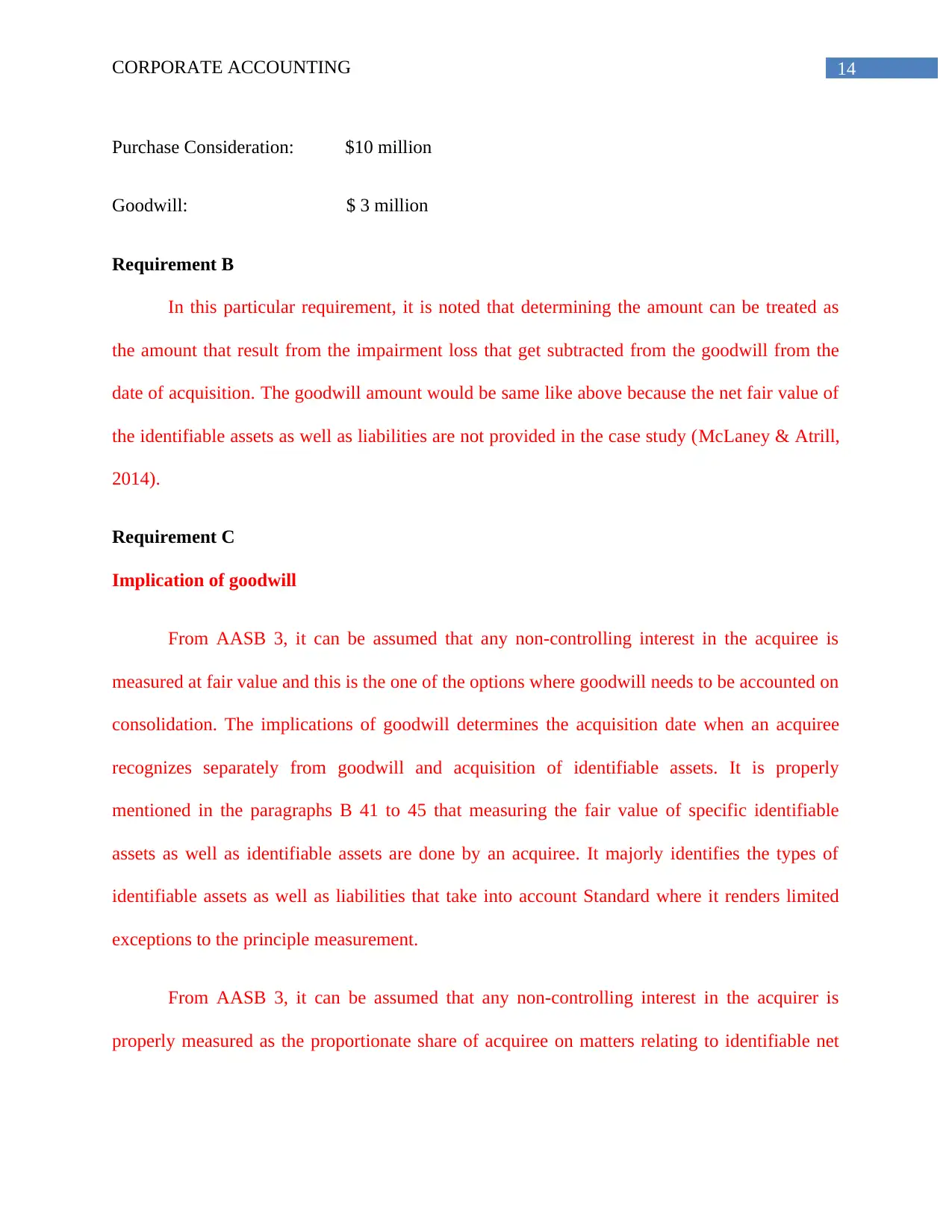
14CORPORATE ACCOUNTING
Purchase Consideration: $10 million
Goodwill: $ 3 million
Requirement B
In this particular requirement, it is noted that determining the amount can be treated as
the amount that result from the impairment loss that get subtracted from the goodwill from the
date of acquisition. The goodwill amount would be same like above because the net fair value of
the identifiable assets as well as liabilities are not provided in the case study (McLaney & Atrill,
2014).
Requirement C
Implication of goodwill
From AASB 3, it can be assumed that any non-controlling interest in the acquiree is
measured at fair value and this is the one of the options where goodwill needs to be accounted on
consolidation. The implications of goodwill determines the acquisition date when an acquiree
recognizes separately from goodwill and acquisition of identifiable assets. It is properly
mentioned in the paragraphs B 41 to 45 that measuring the fair value of specific identifiable
assets as well as identifiable assets are done by an acquiree. It majorly identifies the types of
identifiable assets as well as liabilities that take into account Standard where it renders limited
exceptions to the principle measurement.
From AASB 3, it can be assumed that any non-controlling interest in the acquirer is
properly measured as the proportionate share of acquiree on matters relating to identifiable net
Purchase Consideration: $10 million
Goodwill: $ 3 million
Requirement B
In this particular requirement, it is noted that determining the amount can be treated as
the amount that result from the impairment loss that get subtracted from the goodwill from the
date of acquisition. The goodwill amount would be same like above because the net fair value of
the identifiable assets as well as liabilities are not provided in the case study (McLaney & Atrill,
2014).
Requirement C
Implication of goodwill
From AASB 3, it can be assumed that any non-controlling interest in the acquiree is
measured at fair value and this is the one of the options where goodwill needs to be accounted on
consolidation. The implications of goodwill determines the acquisition date when an acquiree
recognizes separately from goodwill and acquisition of identifiable assets. It is properly
mentioned in the paragraphs B 41 to 45 that measuring the fair value of specific identifiable
assets as well as identifiable assets are done by an acquiree. It majorly identifies the types of
identifiable assets as well as liabilities that take into account Standard where it renders limited
exceptions to the principle measurement.
From AASB 3, it can be assumed that any non-controlling interest in the acquirer is
properly measured as the proportionate share of acquiree on matters relating to identifiable net

15CORPORATE ACCOUNTING
assets. In the paragraphs B 23 to 24, it is mentioned about non-controlling interest share of an
acquiree that carries the amount of retained earnings as well as other equity interests.
Question 5
Particulars
Carrying
Amount Fair Value
Net Fair
Value
Share Capital $0 $200,000 $200,000
Retained Earnings $0 $180,000 $180,000
Net Fair Value of Identifiable
Assets & Liabilities A $380,000
Purchase Consideration B $356,000
Gain on Bargain Purchase C=B-A ($24,000)
Acquisition Analysis:
assets. In the paragraphs B 23 to 24, it is mentioned about non-controlling interest share of an
acquiree that carries the amount of retained earnings as well as other equity interests.
Question 5
Particulars
Carrying
Amount Fair Value
Net Fair
Value
Share Capital $0 $200,000 $200,000
Retained Earnings $0 $180,000 $180,000
Net Fair Value of Identifiable
Assets & Liabilities A $380,000
Purchase Consideration B $356,000
Gain on Bargain Purchase C=B-A ($24,000)
Acquisition Analysis:
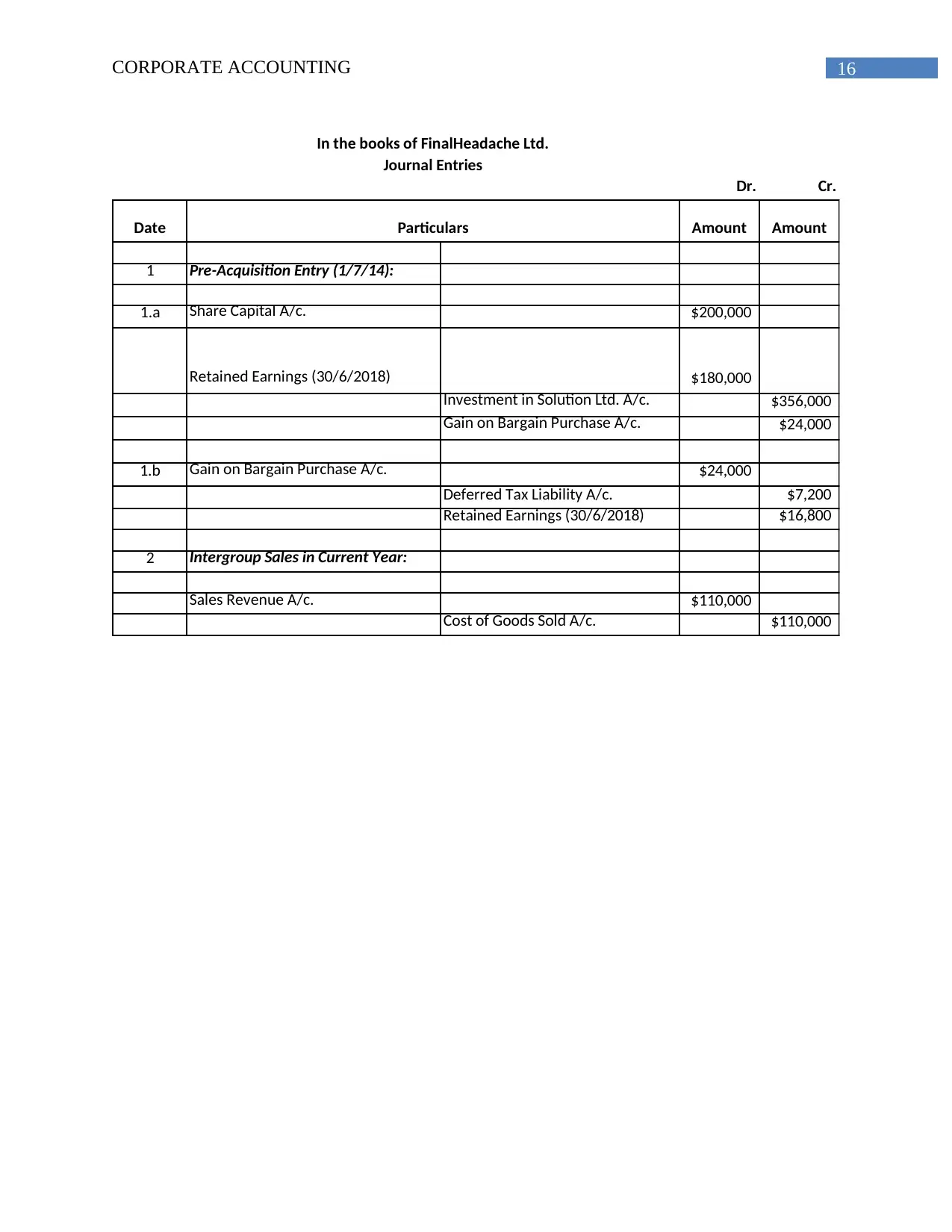
16CORPORATE ACCOUNTING
Dr. Cr.
Date Amount Amount
1 Pre-Acquisition Entry (1/7/14):
1.a Share Capital A/c. $200,000
Retained Earnings (30/6/2018) $180,000
Investment in Solution Ltd. A/c. $356,000
Gain on Bargain Purchase A/c. $24,000
1.b Gain on Bargain Purchase A/c. $24,000
Deferred Tax Liability A/c. $7,200
Retained Earnings (30/6/2018) $16,800
2 Intergroup Sales in Current Year:
Sales Revenue A/c. $110,000
Cost of Goods Sold A/c. $110,000
In the books of FinalHeadache Ltd.
Journal Entries
Particulars
Dr. Cr.
Date Amount Amount
1 Pre-Acquisition Entry (1/7/14):
1.a Share Capital A/c. $200,000
Retained Earnings (30/6/2018) $180,000
Investment in Solution Ltd. A/c. $356,000
Gain on Bargain Purchase A/c. $24,000
1.b Gain on Bargain Purchase A/c. $24,000
Deferred Tax Liability A/c. $7,200
Retained Earnings (30/6/2018) $16,800
2 Intergroup Sales in Current Year:
Sales Revenue A/c. $110,000
Cost of Goods Sold A/c. $110,000
In the books of FinalHeadache Ltd.
Journal Entries
Particulars
Secure Best Marks with AI Grader
Need help grading? Try our AI Grader for instant feedback on your assignments.
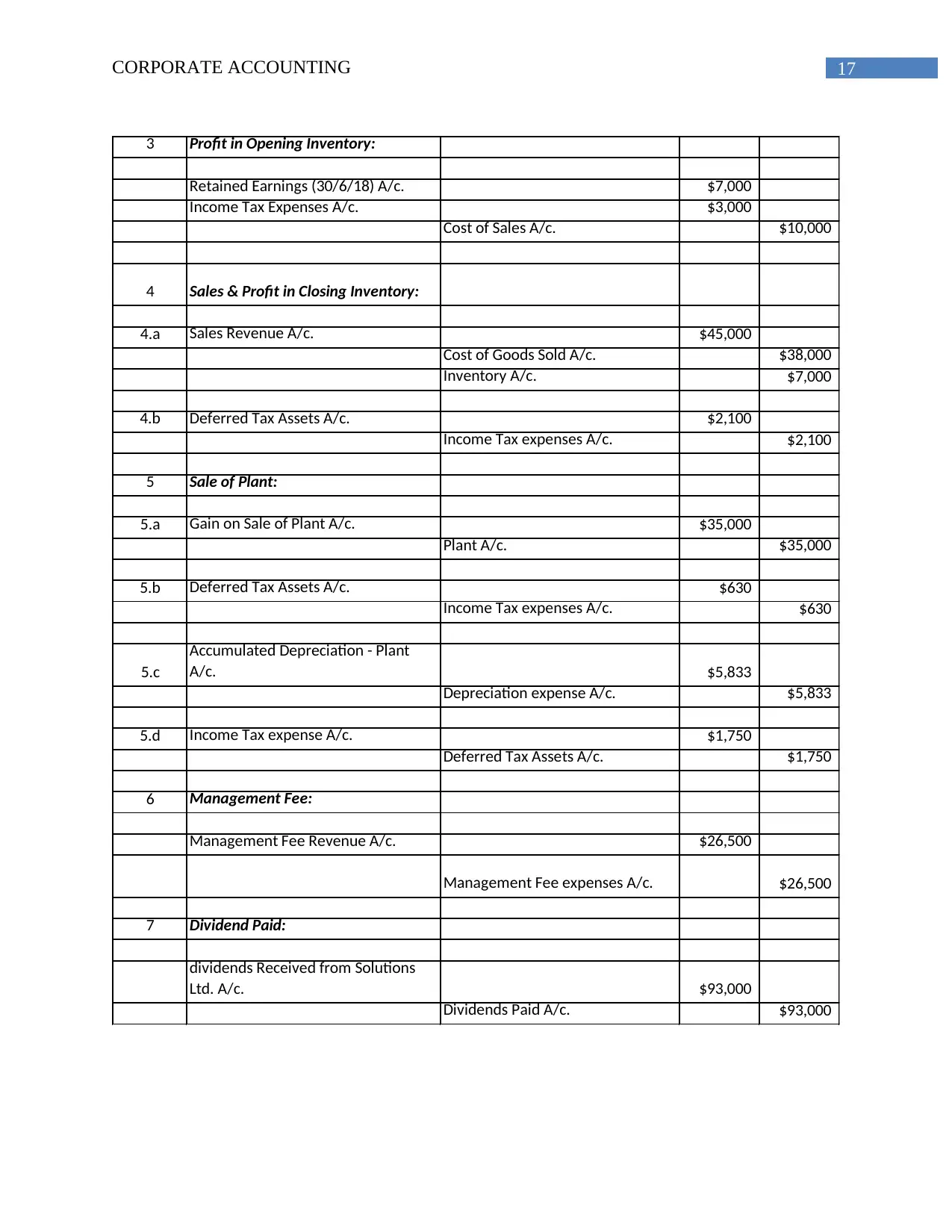
17CORPORATE ACCOUNTING
3 Profit in Opening Inventory:
Retained Earnings (30/6/18) A/c. $7,000
Income Tax Expenses A/c. $3,000
Cost of Sales A/c. $10,000
4 Sales & Profit in Closing Inventory:
4.a Sales Revenue A/c. $45,000
Cost of Goods Sold A/c. $38,000
Inventory A/c. $7,000
4.b Deferred Tax Assets A/c. $2,100
Income Tax expenses A/c. $2,100
5 Sale of Plant:
5.a Gain on Sale of Plant A/c. $35,000
Plant A/c. $35,000
5.b Deferred Tax Assets A/c. $630
Income Tax expenses A/c. $630
5.c
Accumulated Depreciation - Plant
A/c. $5,833
Depreciation expense A/c. $5,833
5.d Income Tax expense A/c. $1,750
Deferred Tax Assets A/c. $1,750
6 Management Fee:
Management Fee Revenue A/c. $26,500
Management Fee expenses A/c. $26,500
7 Dividend Paid:
dividends Received from Solutions
Ltd. A/c. $93,000
Dividends Paid A/c. $93,000
3 Profit in Opening Inventory:
Retained Earnings (30/6/18) A/c. $7,000
Income Tax Expenses A/c. $3,000
Cost of Sales A/c. $10,000
4 Sales & Profit in Closing Inventory:
4.a Sales Revenue A/c. $45,000
Cost of Goods Sold A/c. $38,000
Inventory A/c. $7,000
4.b Deferred Tax Assets A/c. $2,100
Income Tax expenses A/c. $2,100
5 Sale of Plant:
5.a Gain on Sale of Plant A/c. $35,000
Plant A/c. $35,000
5.b Deferred Tax Assets A/c. $630
Income Tax expenses A/c. $630
5.c
Accumulated Depreciation - Plant
A/c. $5,833
Depreciation expense A/c. $5,833
5.d Income Tax expense A/c. $1,750
Deferred Tax Assets A/c. $1,750
6 Management Fee:
Management Fee Revenue A/c. $26,500
Management Fee expenses A/c. $26,500
7 Dividend Paid:
dividends Received from Solutions
Ltd. A/c. $93,000
Dividends Paid A/c. $93,000
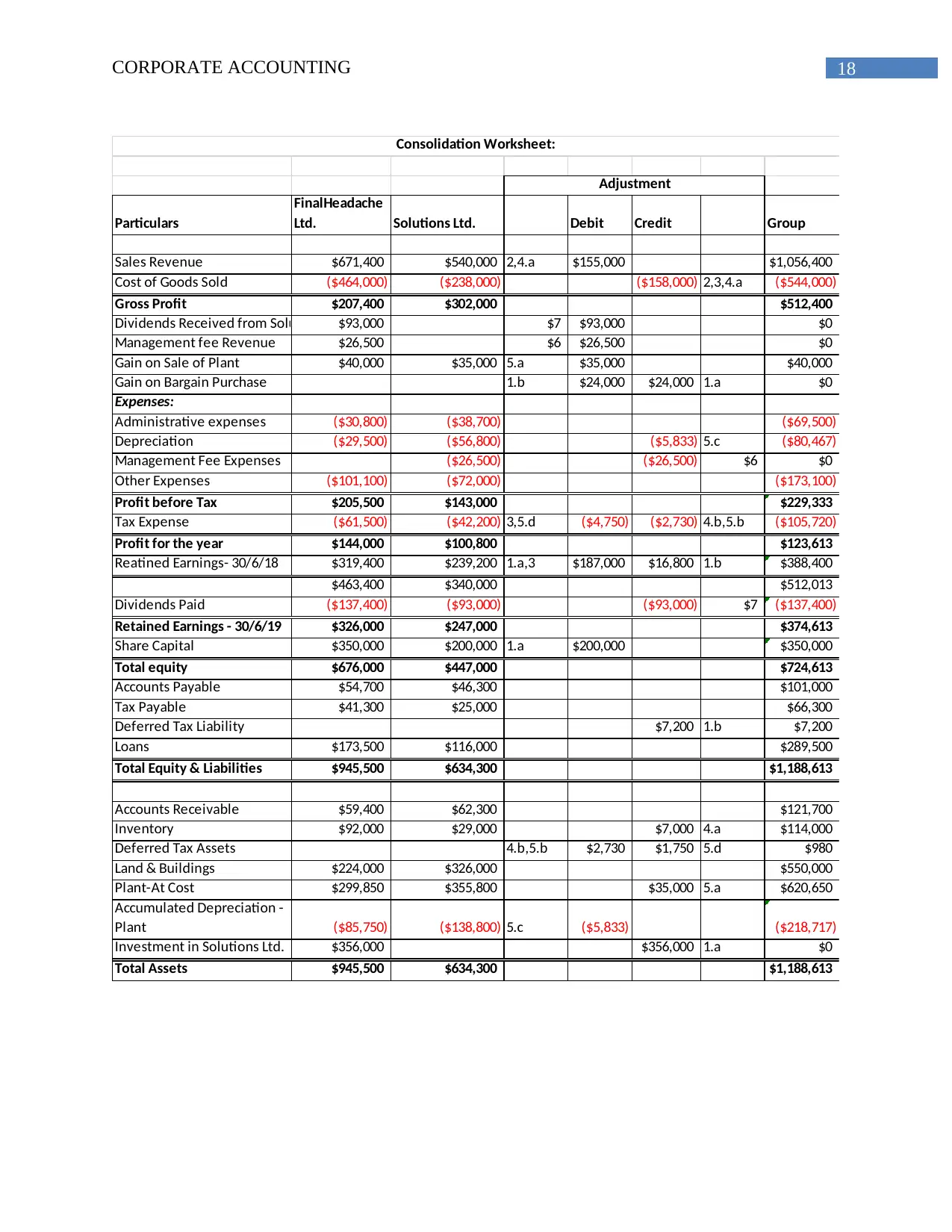
18CORPORATE ACCOUNTING
Particulars
FinalHeadache
Ltd. Solutions Ltd. Debit Credit Group
Sales Revenue $671,400 $540,000 2,4.a $155,000 $1,056,400
Cost of Goods Sold ($464,000) ($238,000) ($158,000) 2,3,4.a ($544,000)
Gross Profit $207,400 $302,000 $512,400
Dividends Received from Solutions Ltd.$93,000 $7 $93,000 $0
Management fee Revenue $26,500 $6 $26,500 $0
Gain on Sale of Plant $40,000 $35,000 5.a $35,000 $40,000
Gain on Bargain Purchase 1.b $24,000 $24,000 1.a $0
Expenses:
Administrative expenses ($30,800) ($38,700) ($69,500)
Depreciation ($29,500) ($56,800) ($5,833) 5.c ($80,467)
Management Fee Expenses ($26,500) ($26,500) $6 $0
Other Expenses ($101,100) ($72,000) ($173,100)
Profit before Tax $205,500 $143,000 $229,333
Tax Expense ($61,500) ($42,200) 3,5.d ($4,750) ($2,730) 4.b,5.b ($105,720)
Profit for the year $144,000 $100,800 $123,613
Reatined Earnings- 30/6/18 $319,400 $239,200 1.a,3 $187,000 $16,800 1.b $388,400
$463,400 $340,000 $512,013
Dividends Paid ($137,400) ($93,000) ($93,000) $7 ($137,400)
Retained Earnings - 30/6/19 $326,000 $247,000 $374,613
Share Capital $350,000 $200,000 1.a $200,000 $350,000
Total equity $676,000 $447,000 $724,613
Accounts Payable $54,700 $46,300 $101,000
Tax Payable $41,300 $25,000 $66,300
Deferred Tax Liability $7,200 1.b $7,200
Loans $173,500 $116,000 $289,500
Total Equity & Liabilities $945,500 $634,300 $1,188,613
Accounts Receivable $59,400 $62,300 $121,700
Inventory $92,000 $29,000 $7,000 4.a $114,000
Deferred Tax Assets 4.b,5.b $2,730 $1,750 5.d $980
Land & Buildings $224,000 $326,000 $550,000
Plant-At Cost $299,850 $355,800 $35,000 5.a $620,650
Accumulated Depreciation -
Plant ($85,750) ($138,800) 5.c ($5,833) ($218,717)
Investment in Solutions Ltd. $356,000 $356,000 1.a $0
Total Assets $945,500 $634,300 $1,188,613
Consolidation Worksheet:
Adjustment
Particulars
FinalHeadache
Ltd. Solutions Ltd. Debit Credit Group
Sales Revenue $671,400 $540,000 2,4.a $155,000 $1,056,400
Cost of Goods Sold ($464,000) ($238,000) ($158,000) 2,3,4.a ($544,000)
Gross Profit $207,400 $302,000 $512,400
Dividends Received from Solutions Ltd.$93,000 $7 $93,000 $0
Management fee Revenue $26,500 $6 $26,500 $0
Gain on Sale of Plant $40,000 $35,000 5.a $35,000 $40,000
Gain on Bargain Purchase 1.b $24,000 $24,000 1.a $0
Expenses:
Administrative expenses ($30,800) ($38,700) ($69,500)
Depreciation ($29,500) ($56,800) ($5,833) 5.c ($80,467)
Management Fee Expenses ($26,500) ($26,500) $6 $0
Other Expenses ($101,100) ($72,000) ($173,100)
Profit before Tax $205,500 $143,000 $229,333
Tax Expense ($61,500) ($42,200) 3,5.d ($4,750) ($2,730) 4.b,5.b ($105,720)
Profit for the year $144,000 $100,800 $123,613
Reatined Earnings- 30/6/18 $319,400 $239,200 1.a,3 $187,000 $16,800 1.b $388,400
$463,400 $340,000 $512,013
Dividends Paid ($137,400) ($93,000) ($93,000) $7 ($137,400)
Retained Earnings - 30/6/19 $326,000 $247,000 $374,613
Share Capital $350,000 $200,000 1.a $200,000 $350,000
Total equity $676,000 $447,000 $724,613
Accounts Payable $54,700 $46,300 $101,000
Tax Payable $41,300 $25,000 $66,300
Deferred Tax Liability $7,200 1.b $7,200
Loans $173,500 $116,000 $289,500
Total Equity & Liabilities $945,500 $634,300 $1,188,613
Accounts Receivable $59,400 $62,300 $121,700
Inventory $92,000 $29,000 $7,000 4.a $114,000
Deferred Tax Assets 4.b,5.b $2,730 $1,750 5.d $980
Land & Buildings $224,000 $326,000 $550,000
Plant-At Cost $299,850 $355,800 $35,000 5.a $620,650
Accumulated Depreciation -
Plant ($85,750) ($138,800) 5.c ($5,833) ($218,717)
Investment in Solutions Ltd. $356,000 $356,000 1.a $0
Total Assets $945,500 $634,300 $1,188,613
Consolidation Worksheet:
Adjustment
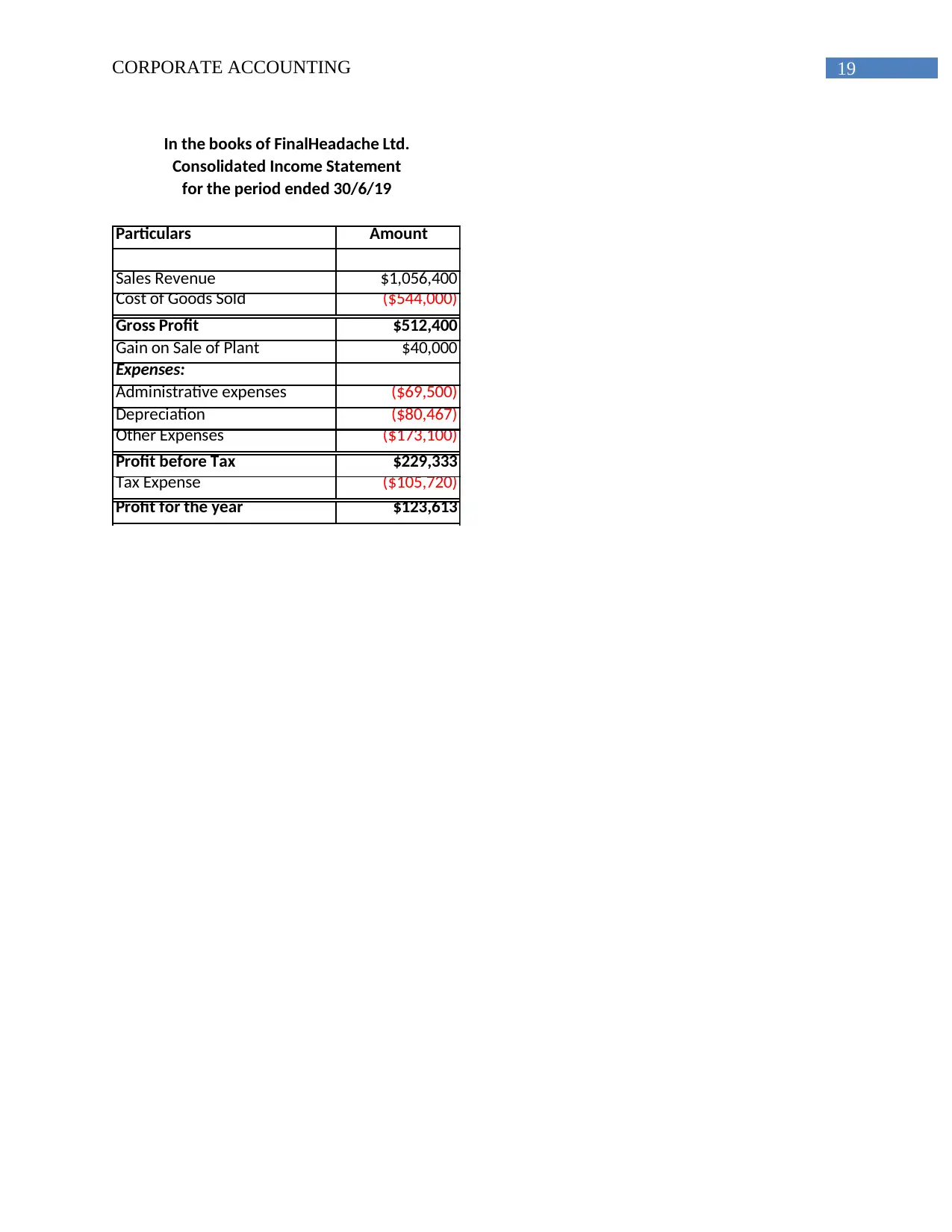
19CORPORATE ACCOUNTING
Particulars Amount
Sales Revenue $1,056,400
Cost of Goods Sold ($544,000)
Gross Profit $512,400
Gain on Sale of Plant $40,000
Expenses:
Administrative expenses ($69,500)
Depreciation ($80,467)
Other Expenses ($173,100)
Profit before Tax $229,333
Tax Expense ($105,720)
Profit for the year $123,613
In the books of FinalHeadache Ltd.
Consolidated Income Statement
for the period ended 30/6/19
Particulars Amount
Sales Revenue $1,056,400
Cost of Goods Sold ($544,000)
Gross Profit $512,400
Gain on Sale of Plant $40,000
Expenses:
Administrative expenses ($69,500)
Depreciation ($80,467)
Other Expenses ($173,100)
Profit before Tax $229,333
Tax Expense ($105,720)
Profit for the year $123,613
In the books of FinalHeadache Ltd.
Consolidated Income Statement
for the period ended 30/6/19
Paraphrase This Document
Need a fresh take? Get an instant paraphrase of this document with our AI Paraphraser
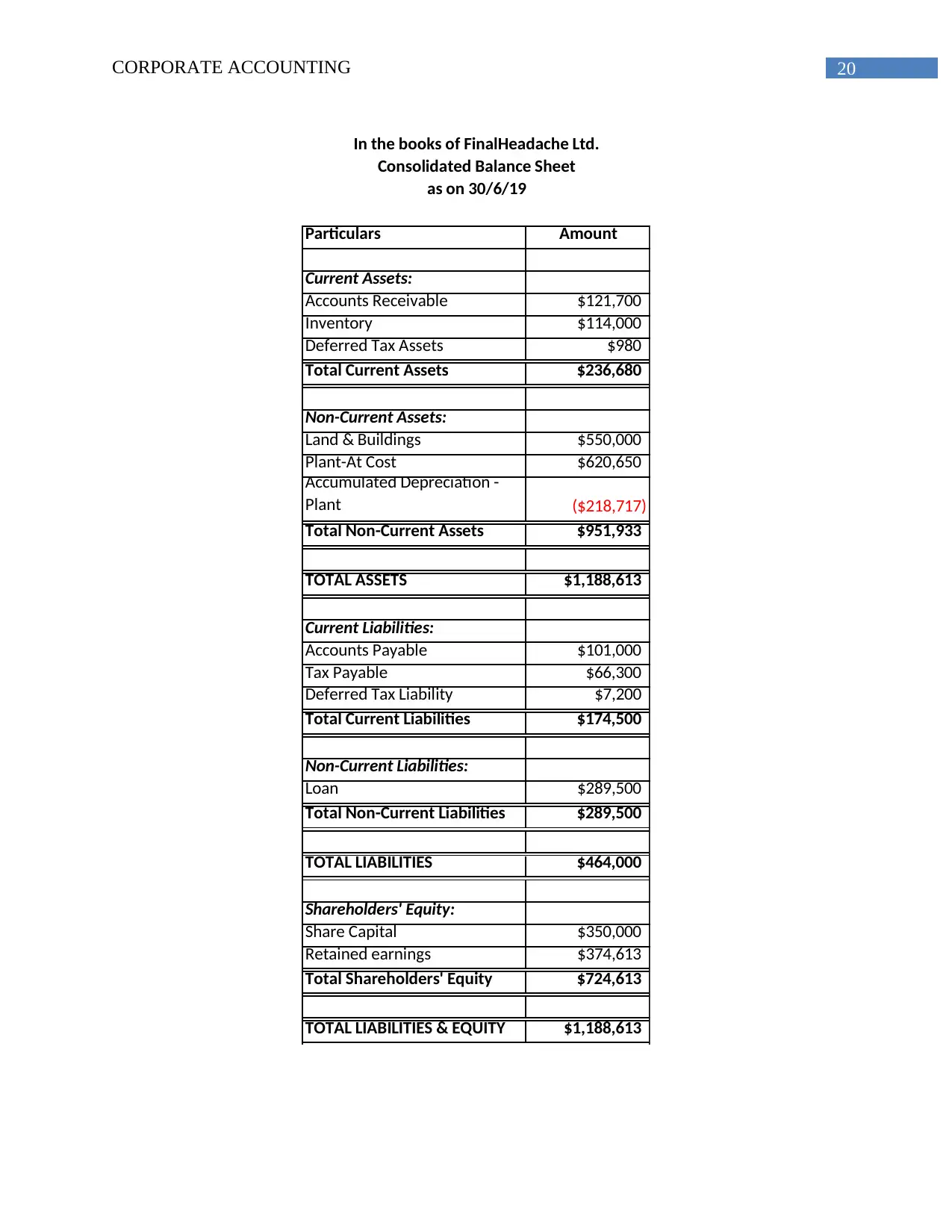
20CORPORATE ACCOUNTING
Particulars Amount
Current Assets:
Accounts Receivable $121,700
Inventory $114,000
Deferred Tax Assets $980
Total Current Assets $236,680
Non-Current Assets:
Land & Buildings $550,000
Plant-At Cost $620,650
Accumulated Depreciation -
Plant ($218,717)
Total Non-Current Assets $951,933
TOTAL ASSETS $1,188,613
Current Liabilities:
Accounts Payable $101,000
Tax Payable $66,300
Deferred Tax Liability $7,200
Total Current Liabilities $174,500
Non-Current Liabilities:
Loan $289,500
Total Non-Current Liabilities $289,500
TOTAL LIABILITIES $464,000
Shareholders' Equity:
Share Capital $350,000
Retained earnings $374,613
Total Shareholders' Equity $724,613
TOTAL LIABILITIES & EQUITY $1,188,613
Consolidated Balance Sheet
as on 30/6/19
In the books of FinalHeadache Ltd.
Particulars Amount
Current Assets:
Accounts Receivable $121,700
Inventory $114,000
Deferred Tax Assets $980
Total Current Assets $236,680
Non-Current Assets:
Land & Buildings $550,000
Plant-At Cost $620,650
Accumulated Depreciation -
Plant ($218,717)
Total Non-Current Assets $951,933
TOTAL ASSETS $1,188,613
Current Liabilities:
Accounts Payable $101,000
Tax Payable $66,300
Deferred Tax Liability $7,200
Total Current Liabilities $174,500
Non-Current Liabilities:
Loan $289,500
Total Non-Current Liabilities $289,500
TOTAL LIABILITIES $464,000
Shareholders' Equity:
Share Capital $350,000
Retained earnings $374,613
Total Shareholders' Equity $724,613
TOTAL LIABILITIES & EQUITY $1,188,613
Consolidated Balance Sheet
as on 30/6/19
In the books of FinalHeadache Ltd.
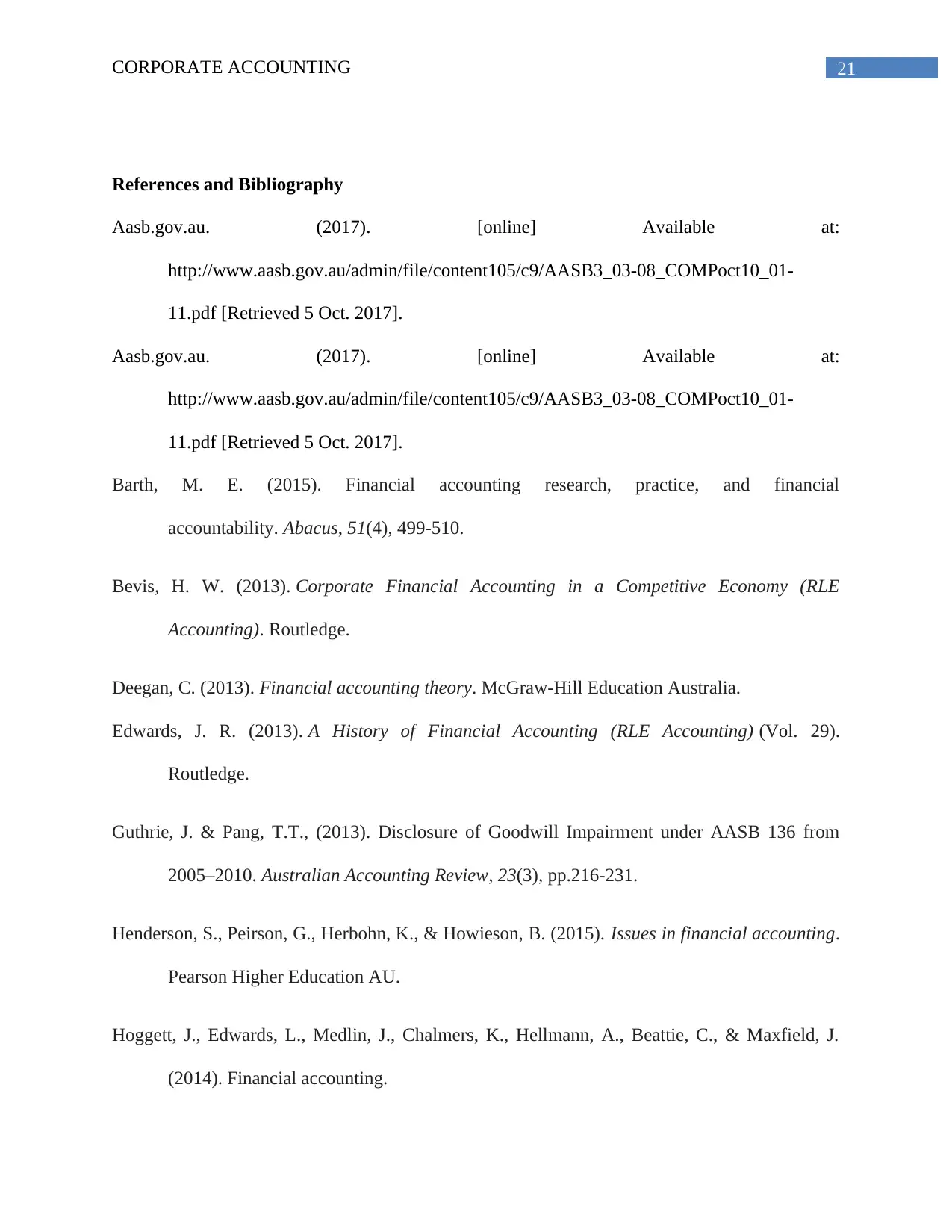
21CORPORATE ACCOUNTING
References and Bibliography
Aasb.gov.au. (2017). [online] Available at:
http://www.aasb.gov.au/admin/file/content105/c9/AASB3_03-08_COMPoct10_01-
11.pdf [Retrieved 5 Oct. 2017].
Aasb.gov.au. (2017). [online] Available at:
http://www.aasb.gov.au/admin/file/content105/c9/AASB3_03-08_COMPoct10_01-
11.pdf [Retrieved 5 Oct. 2017].
Barth, M. E. (2015). Financial accounting research, practice, and financial
accountability. Abacus, 51(4), 499-510.
Bevis, H. W. (2013). Corporate Financial Accounting in a Competitive Economy (RLE
Accounting). Routledge.
Deegan, C. (2013). Financial accounting theory. McGraw-Hill Education Australia.
Edwards, J. R. (2013). A History of Financial Accounting (RLE Accounting) (Vol. 29).
Routledge.
Guthrie, J. & Pang, T.T., (2013). Disclosure of Goodwill Impairment under AASB 136 from
2005–2010. Australian Accounting Review, 23(3), pp.216-231.
Henderson, S., Peirson, G., Herbohn, K., & Howieson, B. (2015). Issues in financial accounting.
Pearson Higher Education AU.
Hoggett, J., Edwards, L., Medlin, J., Chalmers, K., Hellmann, A., Beattie, C., & Maxfield, J.
(2014). Financial accounting.
References and Bibliography
Aasb.gov.au. (2017). [online] Available at:
http://www.aasb.gov.au/admin/file/content105/c9/AASB3_03-08_COMPoct10_01-
11.pdf [Retrieved 5 Oct. 2017].
Aasb.gov.au. (2017). [online] Available at:
http://www.aasb.gov.au/admin/file/content105/c9/AASB3_03-08_COMPoct10_01-
11.pdf [Retrieved 5 Oct. 2017].
Barth, M. E. (2015). Financial accounting research, practice, and financial
accountability. Abacus, 51(4), 499-510.
Bevis, H. W. (2013). Corporate Financial Accounting in a Competitive Economy (RLE
Accounting). Routledge.
Deegan, C. (2013). Financial accounting theory. McGraw-Hill Education Australia.
Edwards, J. R. (2013). A History of Financial Accounting (RLE Accounting) (Vol. 29).
Routledge.
Guthrie, J. & Pang, T.T., (2013). Disclosure of Goodwill Impairment under AASB 136 from
2005–2010. Australian Accounting Review, 23(3), pp.216-231.
Henderson, S., Peirson, G., Herbohn, K., & Howieson, B. (2015). Issues in financial accounting.
Pearson Higher Education AU.
Hoggett, J., Edwards, L., Medlin, J., Chalmers, K., Hellmann, A., Beattie, C., & Maxfield, J.
(2014). Financial accounting.
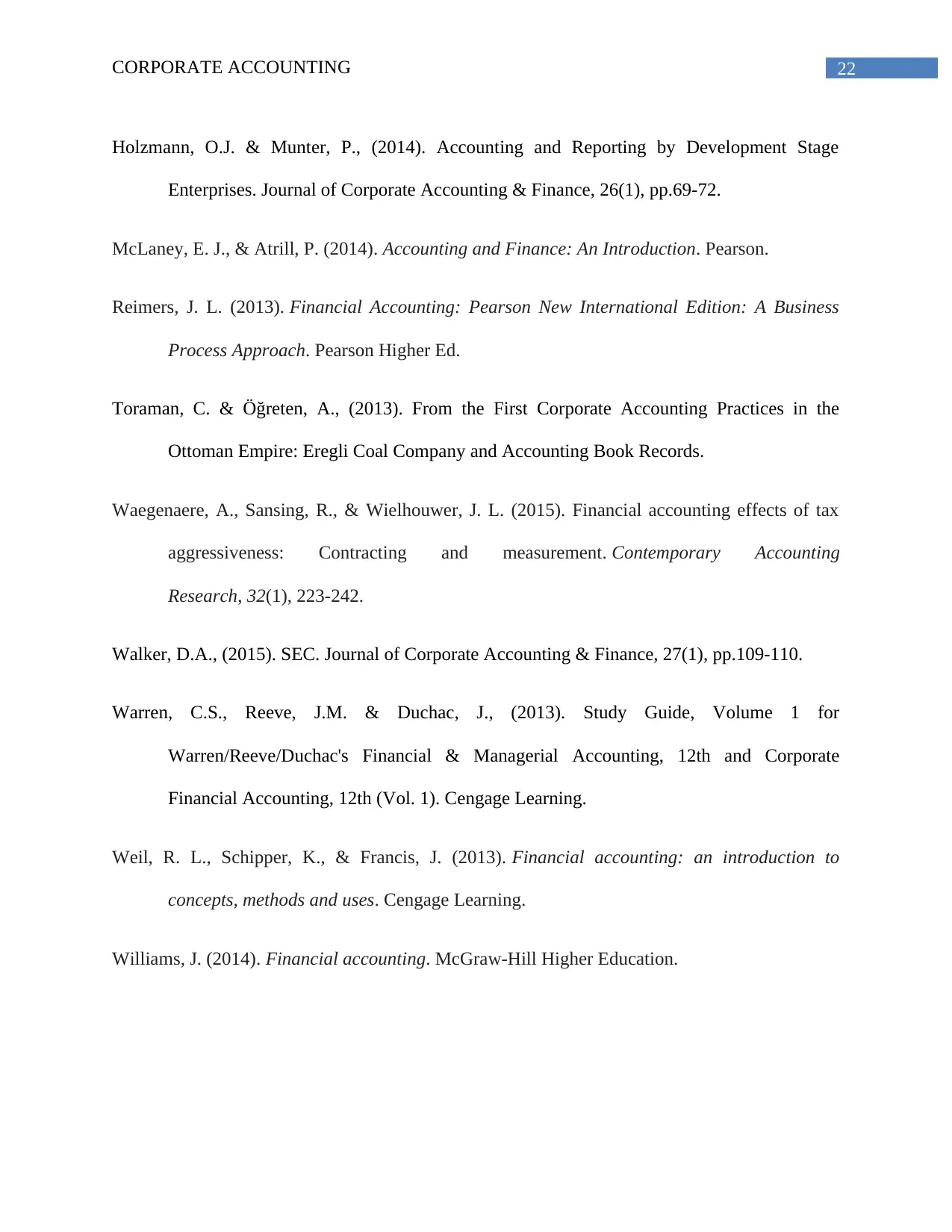
22CORPORATE ACCOUNTING
Holzmann, O.J. & Munter, P., (2014). Accounting and Reporting by Development Stage
Enterprises. Journal of Corporate Accounting & Finance, 26(1), pp.69-72.
McLaney, E. J., & Atrill, P. (2014). Accounting and Finance: An Introduction. Pearson.
Reimers, J. L. (2013). Financial Accounting: Pearson New International Edition: A Business
Process Approach. Pearson Higher Ed.
Toraman, C. & Öğreten, A., (2013). From the First Corporate Accounting Practices in the
Ottoman Empire: Eregli Coal Company and Accounting Book Records.
Waegenaere, A., Sansing, R., & Wielhouwer, J. L. (2015). Financial accounting effects of tax
aggressiveness: Contracting and measurement. Contemporary Accounting
Research, 32(1), 223-242.
Walker, D.A., (2015). SEC. Journal of Corporate Accounting & Finance, 27(1), pp.109-110.
Warren, C.S., Reeve, J.M. & Duchac, J., (2013). Study Guide, Volume 1 for
Warren/Reeve/Duchac's Financial & Managerial Accounting, 12th and Corporate
Financial Accounting, 12th (Vol. 1). Cengage Learning.
Weil, R. L., Schipper, K., & Francis, J. (2013). Financial accounting: an introduction to
concepts, methods and uses. Cengage Learning.
Williams, J. (2014). Financial accounting. McGraw-Hill Higher Education.
Holzmann, O.J. & Munter, P., (2014). Accounting and Reporting by Development Stage
Enterprises. Journal of Corporate Accounting & Finance, 26(1), pp.69-72.
McLaney, E. J., & Atrill, P. (2014). Accounting and Finance: An Introduction. Pearson.
Reimers, J. L. (2013). Financial Accounting: Pearson New International Edition: A Business
Process Approach. Pearson Higher Ed.
Toraman, C. & Öğreten, A., (2013). From the First Corporate Accounting Practices in the
Ottoman Empire: Eregli Coal Company and Accounting Book Records.
Waegenaere, A., Sansing, R., & Wielhouwer, J. L. (2015). Financial accounting effects of tax
aggressiveness: Contracting and measurement. Contemporary Accounting
Research, 32(1), 223-242.
Walker, D.A., (2015). SEC. Journal of Corporate Accounting & Finance, 27(1), pp.109-110.
Warren, C.S., Reeve, J.M. & Duchac, J., (2013). Study Guide, Volume 1 for
Warren/Reeve/Duchac's Financial & Managerial Accounting, 12th and Corporate
Financial Accounting, 12th (Vol. 1). Cengage Learning.
Weil, R. L., Schipper, K., & Francis, J. (2013). Financial accounting: an introduction to
concepts, methods and uses. Cengage Learning.
Williams, J. (2014). Financial accounting. McGraw-Hill Higher Education.
1 out of 22
Related Documents
Your All-in-One AI-Powered Toolkit for Academic Success.
+13062052269
info@desklib.com
Available 24*7 on WhatsApp / Email
![[object Object]](/_next/static/media/star-bottom.7253800d.svg)
Unlock your academic potential
© 2024 | Zucol Services PVT LTD | All rights reserved.





